While Origami Risk still stands out for its depth across risk registers, claims, and policy management, many organizations are finding that its complexity, pricing opacity, and slow adaptability no longer fit the pace of today’s GRC demands.
As compliance landscapes evolve and leadership expects faster insights, teams are asking a familiar question:
Is Origami Risk still getting the job done, or is it time to switch to a platform that’s more agile, transparent, and built for modern governance?
In this guide, I’ll explore the 10 best Origami Risk alternatives and competitors in 2026 - from AI-driven enterprise platforms to no-code GRC solutions that deliver full visibility without the legacy friction.
This way, everyone will find their ideal Origami Risk, regardless of whether you’re managing audits, vendor risk, incidents, or compliance programs.
Let’s begin!
TL;DR
- SmartSuite is the best overall Origami Risk alternative for 2026, combining no-code flexibility, transparent pricing, and a unified GRC platform that centralizes risk, audit, policy, vendor, and incident management in one intuitive workspace.
- SAP GRC, Workiva, and MetricStream stand out for large enterprises needing deep integrations, automated control monitoring, and advanced analytics across complex environments.
- LogicManager and Riskonnect excel at delivering configurable, connected ERM solutions that bridge operational, strategic, and insurable risks.
- Diligent leads in board governance and executive-level oversight, while Resolver offers robust incident, security, and brand reputation management.
- Protecht and SureCloud bring AI-enhanced intelligence and event-based automation to modern GRC programs, helping teams act faster, stay compliant, and scale with confidence.
Why look for an Origami Risk alternative in 2026?
There’s no denying that Origami Risk remains a respected, enterprise-grade platform for risk, insurance, safety, and compliance management.
It centralizes workflows, simplifies claims administration, and offers deep configurability across industries like healthcare, construction, and insurance.
But in 2026, GRC leaders are starting to notice that flexibility alone isn’t enough.
While Origami Risk delivers a solid foundation for large organizations, many teams find it harder to adapt and scale without friction.
Here are the main reasons why more companies are exploring alternatives this year:
1. Non-transparent pricing model
Origami Risk doesn’t publish pricing information publicly, leaving organizations uncertain about total cost until late in the buying process.
Without clear pricing tiers or trials, smaller teams and mid-market organizations find it difficult to evaluate fit, budget, or scalability early on.
Moreover, the fact that Origami Risk doesn’t offer free self-serve trials, leads to a lot of back-and-forth setup discussions and lengthy demos before potential users can see value.
A construction industry user said they wished it were more “plug-and-play” rather than requiring lengthy demos and setup discussions before seeing value.
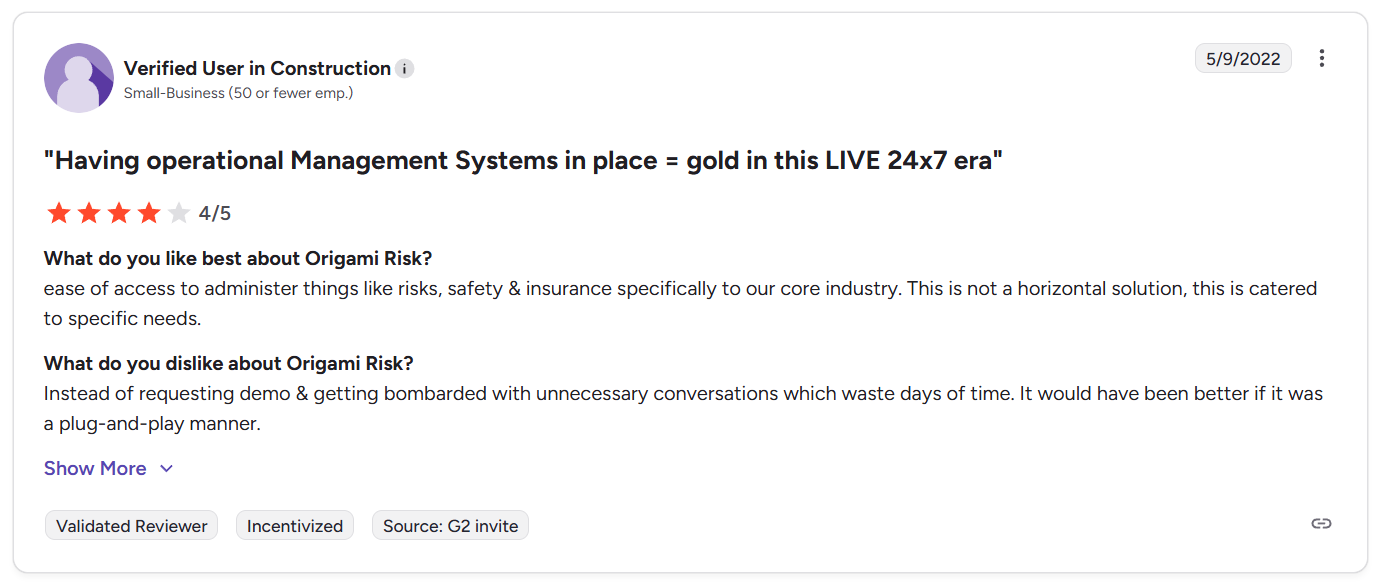
“Instead of requesting demo & getting bombarded with unnecessary conversations which waste days of time. It would have been better if it was a plug-and-play manner.” - G2 Review
2. Significant learning curve
Reviewers frequently describe Origami Risk as powerful but not intuitive.
The platform offers extensive configuration options, yet new users often struggle to navigate its workflows or perform routine tasks like personalization without additional guidance.

“The website is hard to personalize to a more user-friendly view.” - G2 Review
That steep learning curve slows adoption - particularly for non-technical teams that expect modern, intuitive interfaces and minimal onboarding time.
3. Dated interface and user experience limitations
While Origami’s functionality is broad, several users mention that the interface feels dated and that certain actions, like attaching photos or customizing dashboards, aren’t always straightforward.
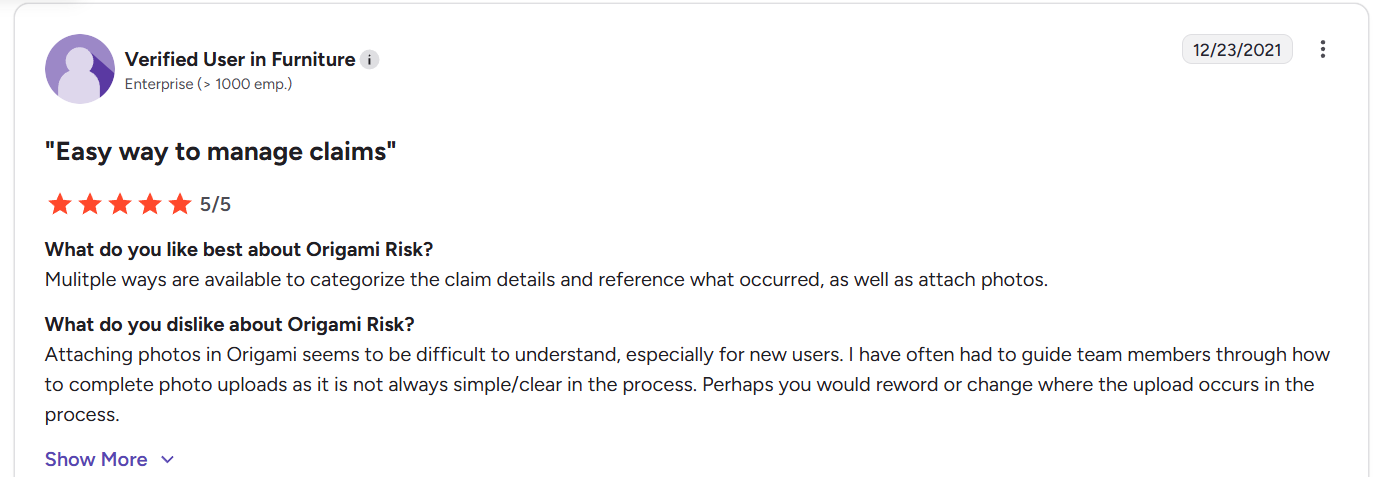
“Attaching photos in Origami seems to be difficult to understand, especially for new users. I have often had to guide team members through how to complete photo uploads as it is not always simple/clear in the process.” - G2 Review
This friction adds unnecessary steps to what should be quick, everyday actions.
What are the best Origami Risk alternatives and competitors in 2026?
The best alternatives to Origami Risk in 2026 are SmartSuite, SAP GRC, and Workiva, as they combine strong governance, risk, and compliance capabilities with modern automation, and faster implementation.
Here are the top 10 tools worth considering this year:
1. SmartSuite: A unified, no-code GRC platform that centralizes risk, audit, policy, and vendor management with real-time visibility and effortless customization.
2. SAP GRC: Enterprise-grade compliance software built for large organizations that need deep SAP integration and advanced access control.
3. Workiva: A connected reporting platform that links risk, audit, ESG, and finance data to streamline compliance and board reporting.
4. MetricStream: An AI-driven GRC suite for complex, regulated enterprises focused on automation, analytics, and continuous control monitoring.
5. LogicManager: A user-friendly GRC tool for mid-market teams that simplifies risk registers, frameworks, and compliance workflows
6. Riskonnect: A comprehensive platform combining enterprise, operational, and insurable risk management with real-time analytics.
7. Diligent: A governance-first platform uniting board oversight, audit, and risk data for executive visibility and decision support.
8. Resolver: An intuitive incident and risk management tool that helps teams capture, track, and resolve issues faster.
9. Protecht: A flexible GRC solution with strong analytics and configurability for risk, compliance, and incident management.
10. SureCloud: A modern GRC and risk intelligence platform offering no-code automation and continuous control monitoring.
1. SmartSuite
Best for: Teams of any size looking for a modern, no-code platform to manage every GRC workflow in one place.

SmartSuite stands out as the best overall Origami Risk alternative in 2026, offering the same depth of functionality - risk, audit, policy, compliance, vendor, and incident management - but with a far simpler, faster, and more transparent experience.
Built for flexibility, SmartSuite replaces complex implementations with intuitive drag-and-drop configuration, allowing teams to launch complete GRC programs in days instead of months.
Its biggest differentiator is accessibility, as there’s no IT dependency, no hidden fees, and no rigid modules - just one fully connected workspace where risk and compliance live side by side with automation, reporting, and collaboration.
From mapping controls to tracking incidents or visualizing enterprise risk exposure, SmartSuite gives teams the clarity, speed, and customization legacy systems like Origami Risk often lack.
Let’s take a closer look at SmartSuite’s features that GRC teams love the most.
1. A single platform for every GRC workflow
Many GRC tools, including Origami Risk, break their capabilities into separate modules for risk, insurance, compliance, and audit.
SmartSuite takes a very different approach.
It unifies everything into one cohesive workspace where every risk, policy, incident, audit, and vendor record lives side by side, sharing the same data and logic.

This way, instead of hopping between disconnected systems, teams operate inside a single, living environment where information flows automatically.
A new risk entered by one department instantly updates related controls, audit items, and dashboards for everyone else.
There’s no lag, no manual syncing, and no lost context - just continuous, connected visibility.
Here’s how that translates into everyday use:
- Unified workspace: Every GRC process, from audits to risk scoring, runs in one platform, eliminating silos and duplicate data.
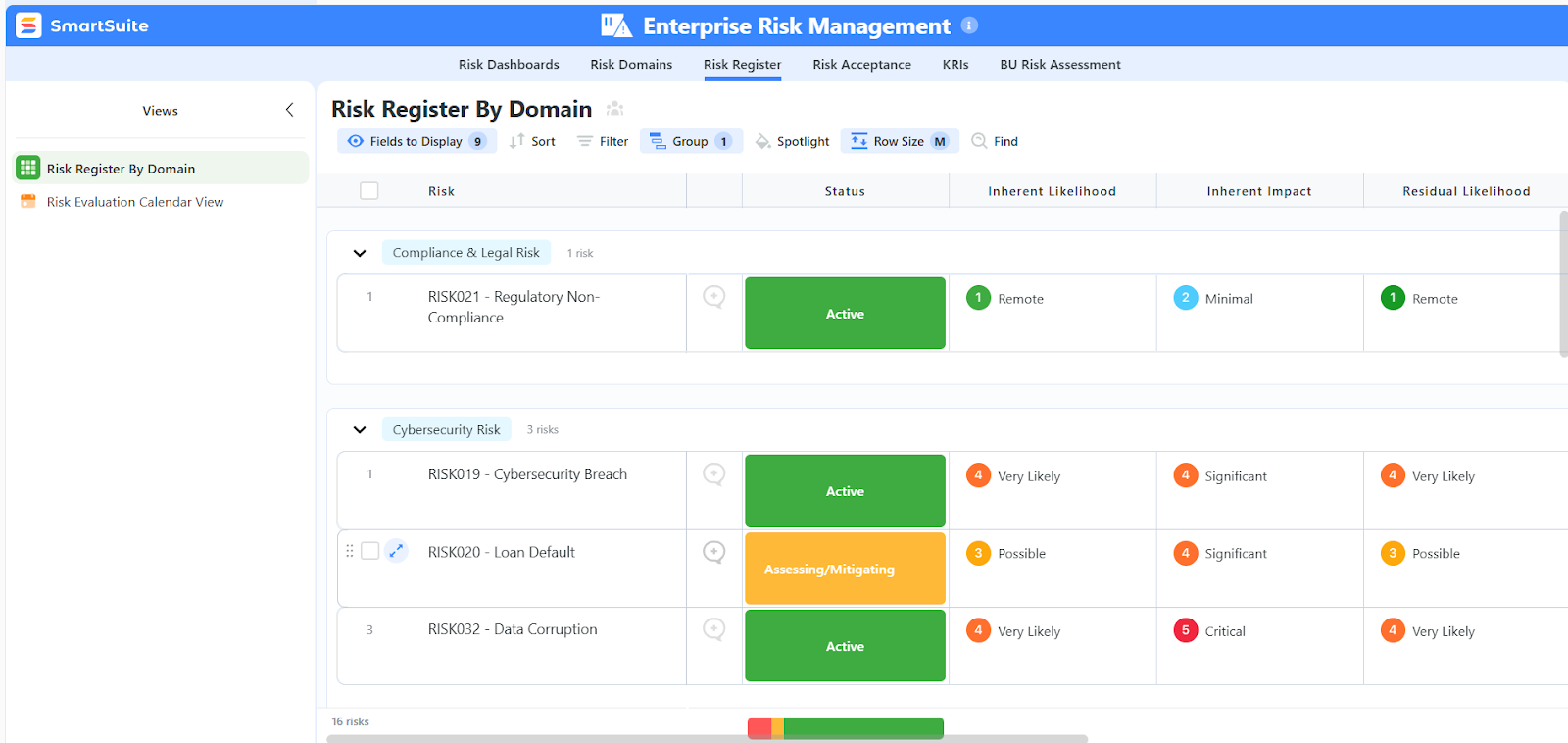
- Dynamic updates: When a risk changes status or a new incident is logged, all related records and dashboards update instantly across the system.
- Real-time intelligence: Leadership and compliance teams can view exposure levels, overdue actions, or audit results live, without exporting data or waiting for reports.
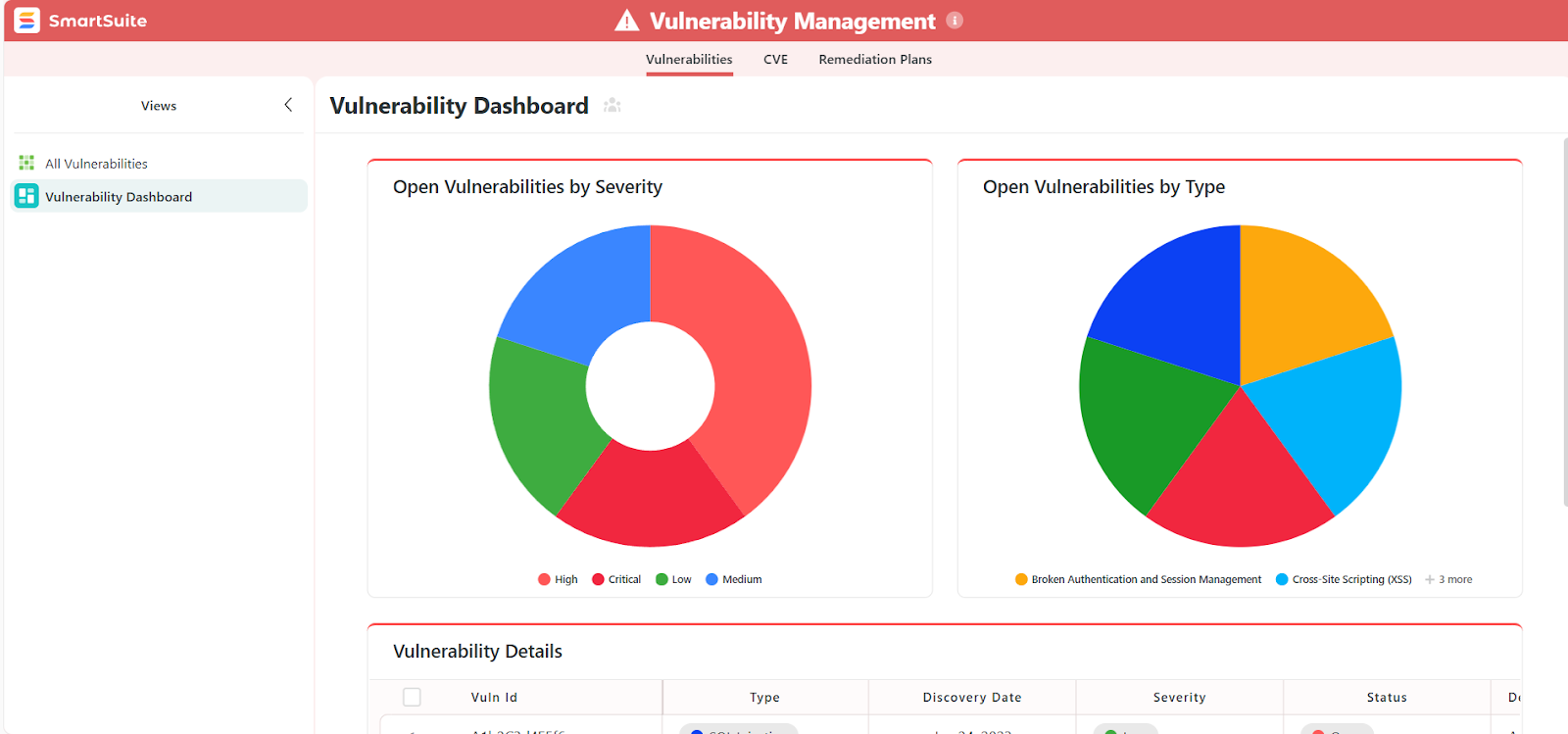
- Automated workflows: Alerts, reviews, approvals, and escalation chains set off automatically the moment thresholds are met, ensuring consistency and accountability.
- Seamless collaboration: Team members can comment, tag colleagues, share files, or assign ownership directly within any record, so conversations happen in context, not in scattered emails or spreadsheets.
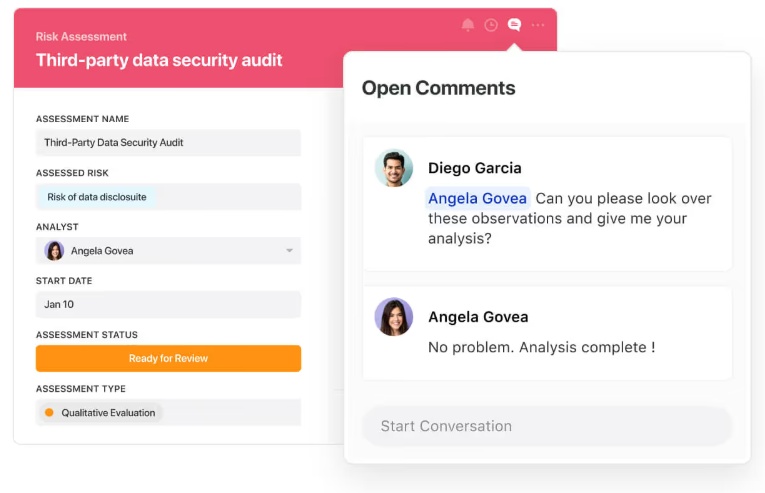
As a result, SmartSuite turns what’s usually a maze of separate tools into one intuitive command center that keeps your entire governance program moving in sync.
2. Enterprise security and scalability without the enterprise complexity
Enterprise risk and compliance teams trust platforms like Origami Risk for their stability and control, but that often comes with a trade-off: rigid infrastructure, slow updates, and heavy reliance on administrators.
SmartSuite takes a different path, delivering the same level of enterprise-grade protection and scalability, but in a lightweight, flexible architecture that adapts as you grow.
Every SmartSuite workspace is built on a defence-in-depth security model, ensuring sensitive governance data remains protected at every layer - whether you’re a mid-market organization or a global enterprise managing multiple entities.
Here’s what that looks like in practice:
- Certified compliance: SmartSuite is fully compliant with leading global standards, including SOC 2, ISO 27701, GDPR, and HIPAA, ensuring every environment meets strict security and privacy requirements.
- Granular access controls: Role-based permissions let you define exactly who can view, edit, or approve records down to the field level, so sensitive data stays within the right hands.

- Regional data residency: For global organizations, SmartSuite offers hosting in multiple regions to help meet jurisdictional or regulatory data requirements.
- End-to-end encryption: Data is encrypted both at rest and in transit, protecting sensitive information from unauthorized access.
- Comprehensive audit logs: Every change, comment, and approval is automatically recorded for traceability, simplifying external audits and compliance verification.
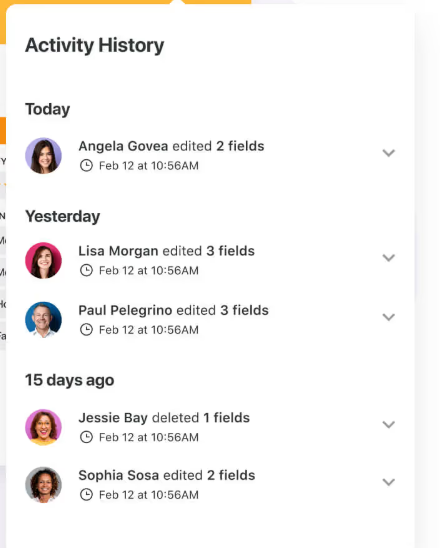
- Data loss prevention: Enterprise plans include configurable retention policies, DLP features, and custom deletion rules to safeguard critical assets.
Because security is baked into the platform instead of bolted on, you don’t need separate add-ons or custom integrations to achieve compliance.
This way, you get the confidence to scale without compromise.
Whether you’re managing 500 users or 50,000, SmartSuite grows with you, keeping performance, protection, and compliance aligned every step of the way.
3. Built to adapt, not overcomplicate
Every organization approaches governance and compliance differently, and that’s exactly why SmartSuite was built around adaptability, not rigidity.
Instead of forcing you into fixed workflows or waiting weeks for vendor-led configuration like Origami Risk often requires, SmartSuite gives you total control to tailor your GRC environment yourself, instantly and without a single line of code.
Everything inside the platform is designed to bend to your processes, not the other way around.
Need to add a new risk field, tweak scoring logic, or adjust a review workflow? It’s all visual and intuitive - drag, drop, and deploy.
Here’s how that flexibility comes to life:
- Visual workflow builder: Automate escalations, reminders, and multi-step approvals to keep assessments and corrective actions moving on schedule.
- Custom KPIs & formulas: Define your own scoring logic to reflect your risk appetite, industry standards, or regulatory frameworks.
- 40+ field types: Capture exactly the data you need, from numeric risk ratings and dropdowns to file uploads, relationship links, and formulas.
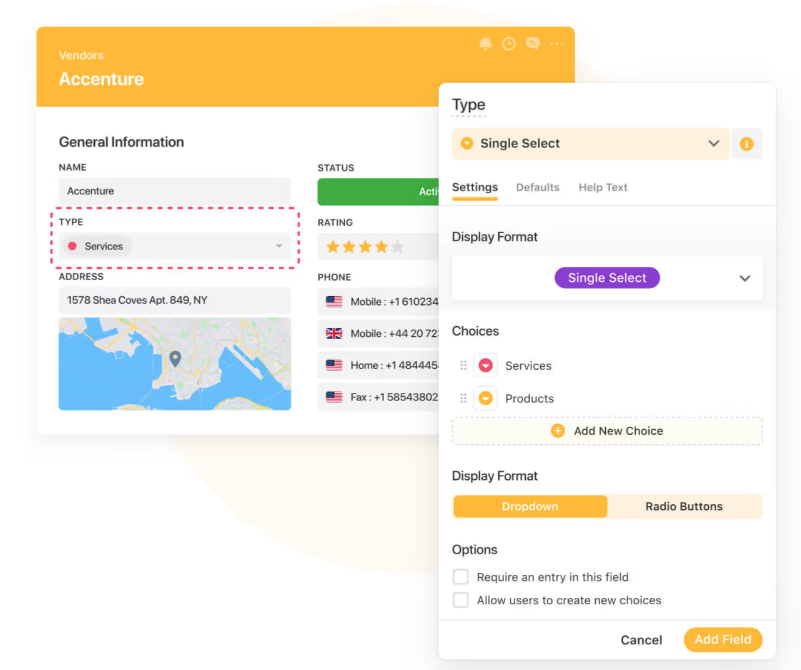
- Native integrations: Connect SmartSuite seamlessly with tools your teams already use, such as Slack, Gmail, Outlook, Teams, or any app via Zapier and API.
In essence, SmartSuite gives you the freedom to grow at your own pace while keeping your governance framework consistent, compliant, and completely under your control.
This way, you can evolve your workflows as regulations change, new frameworks emerge, or your business matures, without external consultants, hidden costs, or downtime.
4. Ready-to-use GRC templates that get you operational fast
One of the biggest pain points with enterprise-level GRC tools like Origami Risk is the setup time, as it takes heavy configuration and vendor guidance to get up and running.
SmartSuite flips that experience completely.
Instead of waiting weeks for implementation, SmartSuite gives you a library of ready-to-use GRC templates that come preconfigured with best-practice fields, workflows, and dashboards, all of which you can adapt instantly to your organization’s processes.
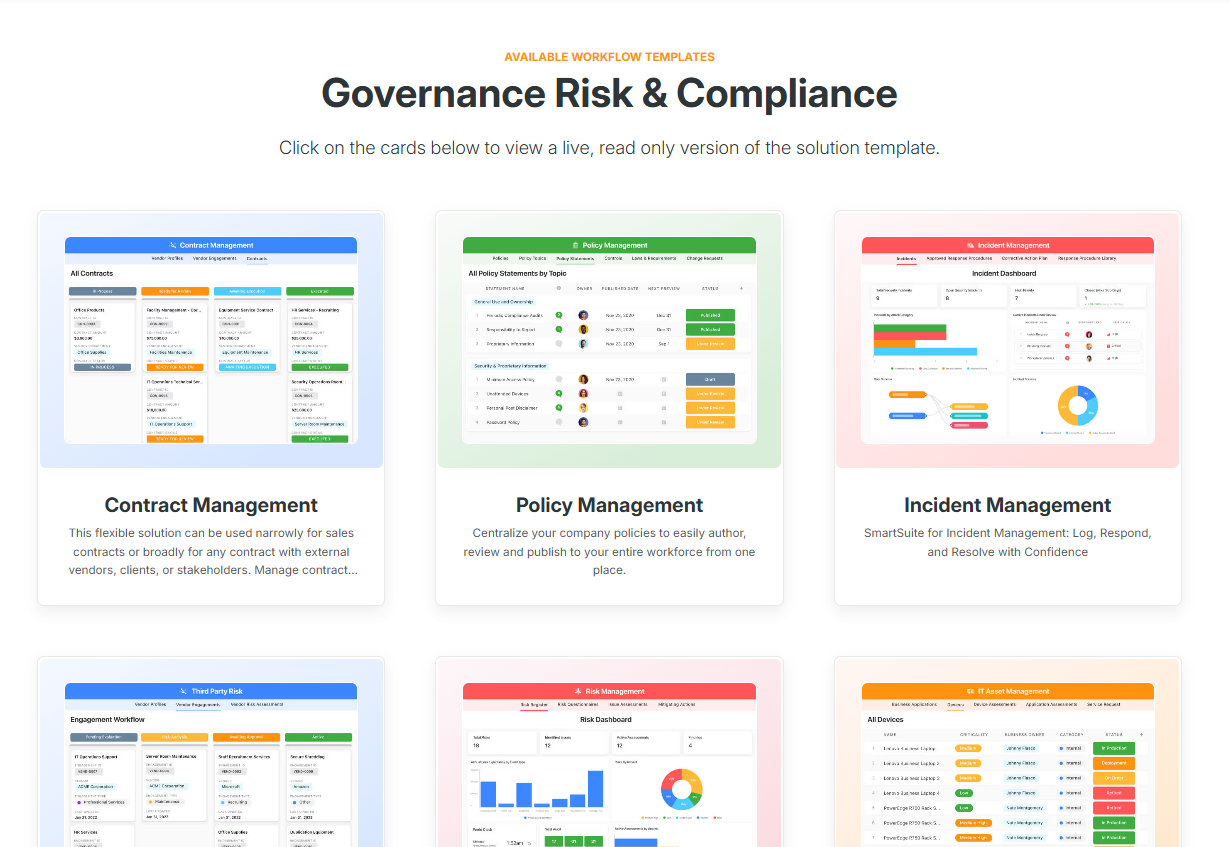
Each template is built around proven governance frameworks, so you’re never starting from scratch.
You simply install, adjust, and go live.
It’s the difference between building a system and starting with one that already works.
Here are some of SmartSuite’s most widely used GRC templates:
- Risk & Control Management: Identify and score enterprise risks, map them to mitigating controls, and monitor exposure through automated scoring and visual dashboards.
- Incident & Issue Tracking: Capture new incidents, assign owners, and escalate when thresholds are breached with built-in audit trails to maintain accountability.
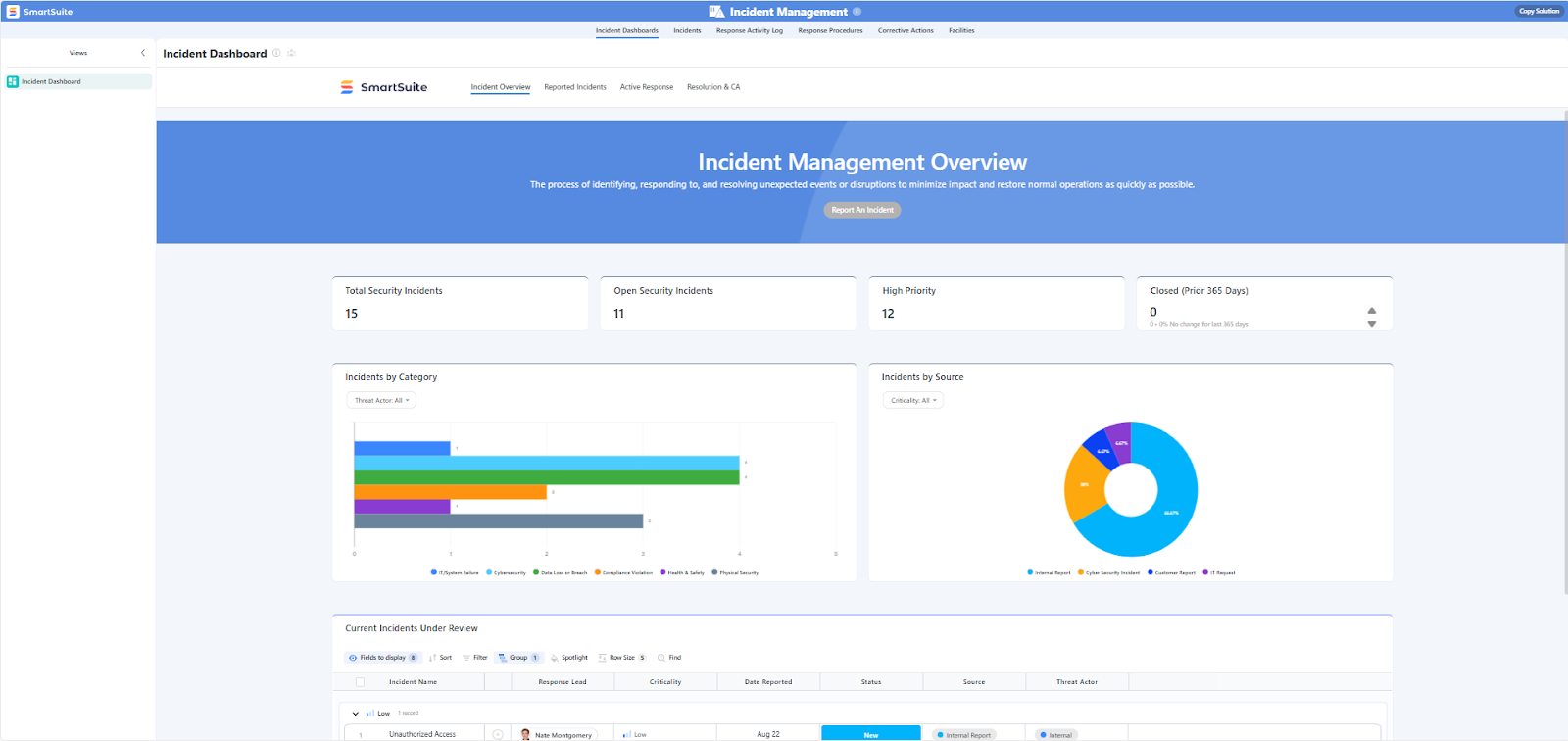
- Regulatory Change Monitoring: Track upcoming or evolving regulations, assess their impact, and log every compliance action in a single, auditable record.
- Policy Management: Manage the full policy lifecycle, including drafting, approval, publishing, and acknowledgment, all with version history and renewal reminders.
- Third-Party & Vendor Risk: Consolidate vendor data, automate due diligence checks, and assign compliance scores based on risk impact or business criticality.
- Audit & RCSA: Schedule audits, track progress, link findings to controls, and automate self-assessments to stay continuously audit-ready.
- Business Continuity & Resilience: Design, test, and review recovery plans, ensuring operational continuity in case of disruption.
Every template can be reconfigured using SmartSuite’s drag-and-drop builder, so teams can tweak fields, workflows, and dashboards on the fly, without calling IT or waiting for consultants.
This modular, no-code foundation means SmartSuite adapts to you, not the other way around.
In just a few hours, your team can go from static spreadsheets and manual checklists to a fully operational GRC environment that’s collaborative, visual, and ready for scale.
Pricing
While Origami Risk relies on custom quotes and lengthy sales cycles, SmartSuite takes a radically more transparent approach to pricing.
Every plan is published, predictable, and scalable, so teams of any size can plan budgets confidently without waiting for a demo or proposal.
You can start for free, expand as you scale, and unlock enterprise-grade features when you’re ready, with no hidden costs, no forced upgrades, and no surprises.
First of all, SmartSuite offers a Free Forever plan designed for individuals and small teams that gives access to core GRC templates, dashboards, real-time collaboration, and reporting features.
It supports up to 3 users, 5 solutions, and 1,000 records per solution, making it ideal for smaller teams or those testing SmartSuite’s GRC capabilities before full adoption.
And if you need more power, SmartSuite’s four paid tiers scale seamlessly with your organization’s growth and compliance maturity:
- Team: $12/user/month, includes everything in Free, plus unlimited solutions, 5,000 records per solution, 50GB of file storage, advanced collaboration tools, and a 30-day recycle bin.
- Professional: $30/user/month, includes everything in Team and adds advanced permissions, two-factor authentication, Gmail & Outlook integrations, AI features, and 100GB of file storage.
- Enterprise: $45/user/month, includes everything in Professional, plus audit logs, data loss prevention, up to 50,000 monthly API calls, and 500GB of file storage.
- Signature: Custom pricing, a fully tailored plan with no predefined limits, offering extended storage, API capacity, records, automations, and advanced enterprise security options such as SCIM provisioning and regional data residency.
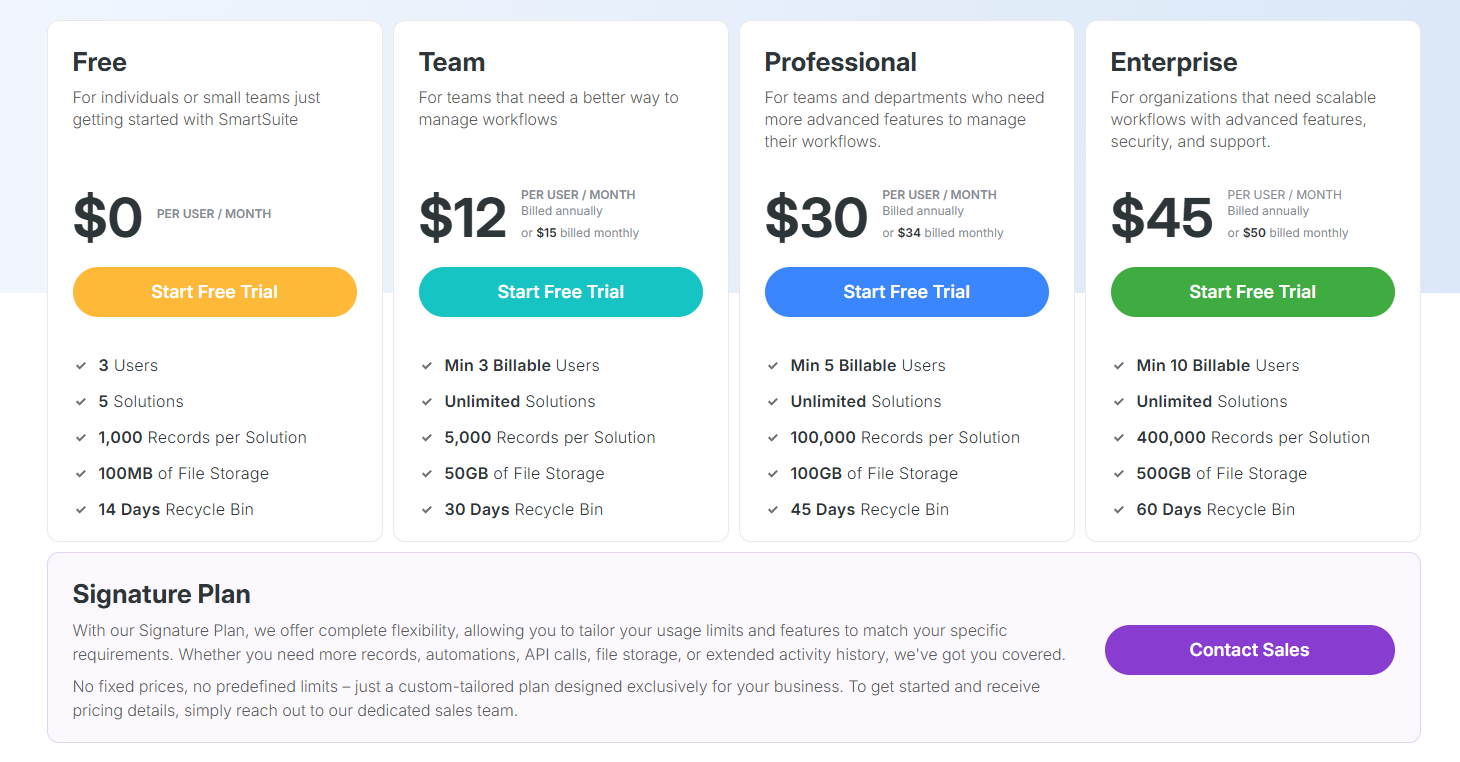
The first three paid plans include a 14-day free trial with no credit card required, allowing teams to explore SmartSuite’s full capabilities before committing.
How does SmartSuite compare to Origami Risk?
Although both platforms aim to simplify governance, risk, and compliance, their approach and user experience couldn’t be further apart.
Origami Risk is known for its depth across insurance, claims, and risk management, but that same depth often comes with added complexity, slower setup, and higher ownership costs.
SmartSuite, on the other hand, was designed for modern teams that want the same power, but with faster deployment, full visibility, and no reliance on IT or consultants.
Here’s how the two platforms stack up in practice:
- Modular vs. unified approach: Origami Risk divides capabilities across multiple modules for insurance, risk, and compliance. SmartSuite brings every GRC process into one connected workspace, where risks, controls, policies, and incidents all live together, automatically updating in real time.
- Ease of use: Users often describe Origami as powerful but not intuitive, with workflows that require guidance or admin support. SmartSuite’s clean, no-code interface and drag-and-drop customization make it easy for any team to get up and running in hours instead of weeks.
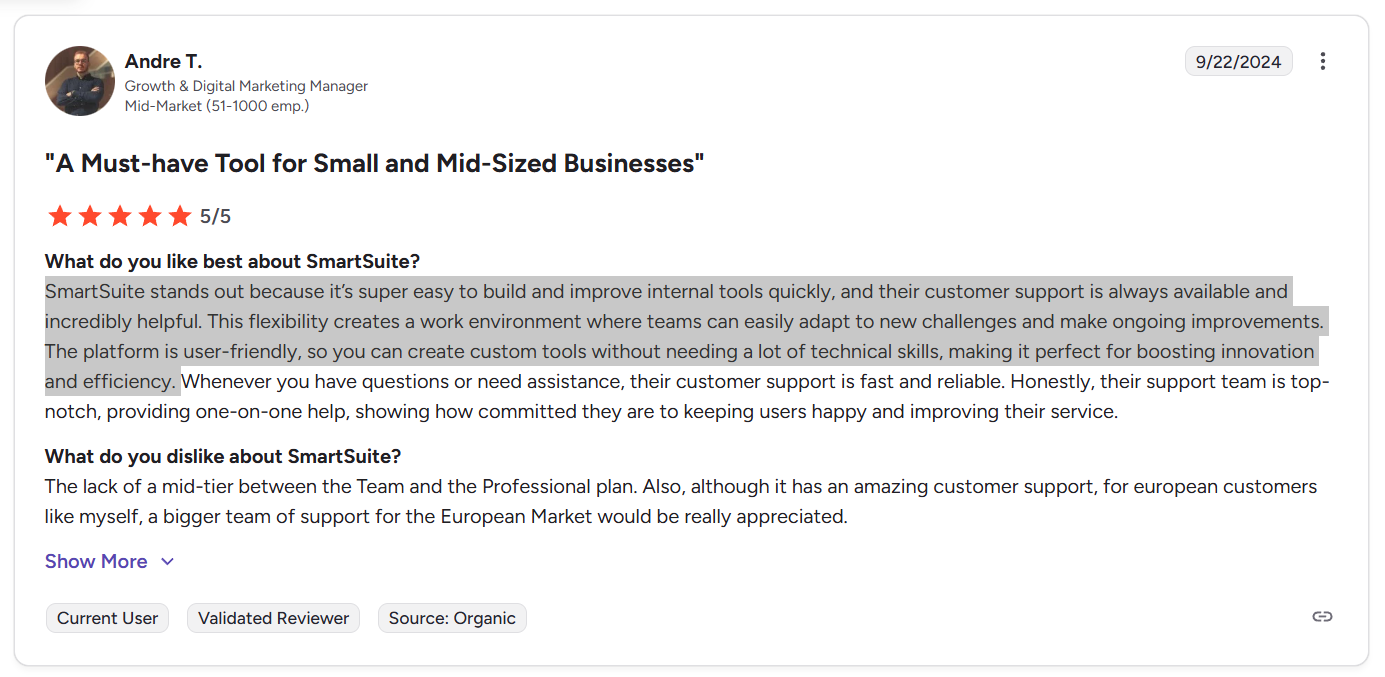
- Pricing transparency: Origami’s pricing isn’t disclosed publicly, which makes it hard for teams to budget or compare options early on, and there’s no free trial that lets you try it out first. SmartSuite’s clear, tiered pricing, plus a free plan and 14-day trial, removes the guesswork entirely, helping teams evaluate value before committing.
- Customization and flexibility: Origami offers deep configuration options, but they often come with added time and cost. SmartSuite puts customization directly in users’ hands, so governance workflows evolve as fast as your business does.

- Security and enterprise readiness: Origami is trusted by enterprise organizations across regulated industries. SmartSuite matches that level of confidence with full SOC 2, ISO 27701, HIPAA, and GDPR compliance, end-to-end encryption, and regional data residency, all within a lighter, more agile architecture.
- Overall user experience: While Origami’s interface can feel dated, SmartSuite delivers a modern, collaborative experience.
In essence, Origami Risk delivers enterprise power, but SmartSuite delivers enterprise power with modern simplicity, giving teams everything they need to manage risk and compliance in one unified, transparent, and easy-to-use platform.
Pros & Cons
✅ No-code customization lets you adapt workflows, fields, and dashboards in minutes without IT or consultants.
✅ Real-time reporting with dynamic dashboards that update automatically, giving leadership instant visibility into risk exposure and compliance progress.
✅ Transparent pricing with a free plan and free trial.
✅ Clean, modern interface with built-in collaboration keeps teams aligned and productive.
✅ Ready-to-use, fully customizable templates.
✅ Enterprise-grade security.
❌ Fewer native integrations than legacy enterprise suites, though API and Zapier connectivity cover most use cases.
2. SAP GRC
Best for: Large, highly regulated organizations already invested in the SAP ecosystem that need deep integration between GRC and enterprise business processes.
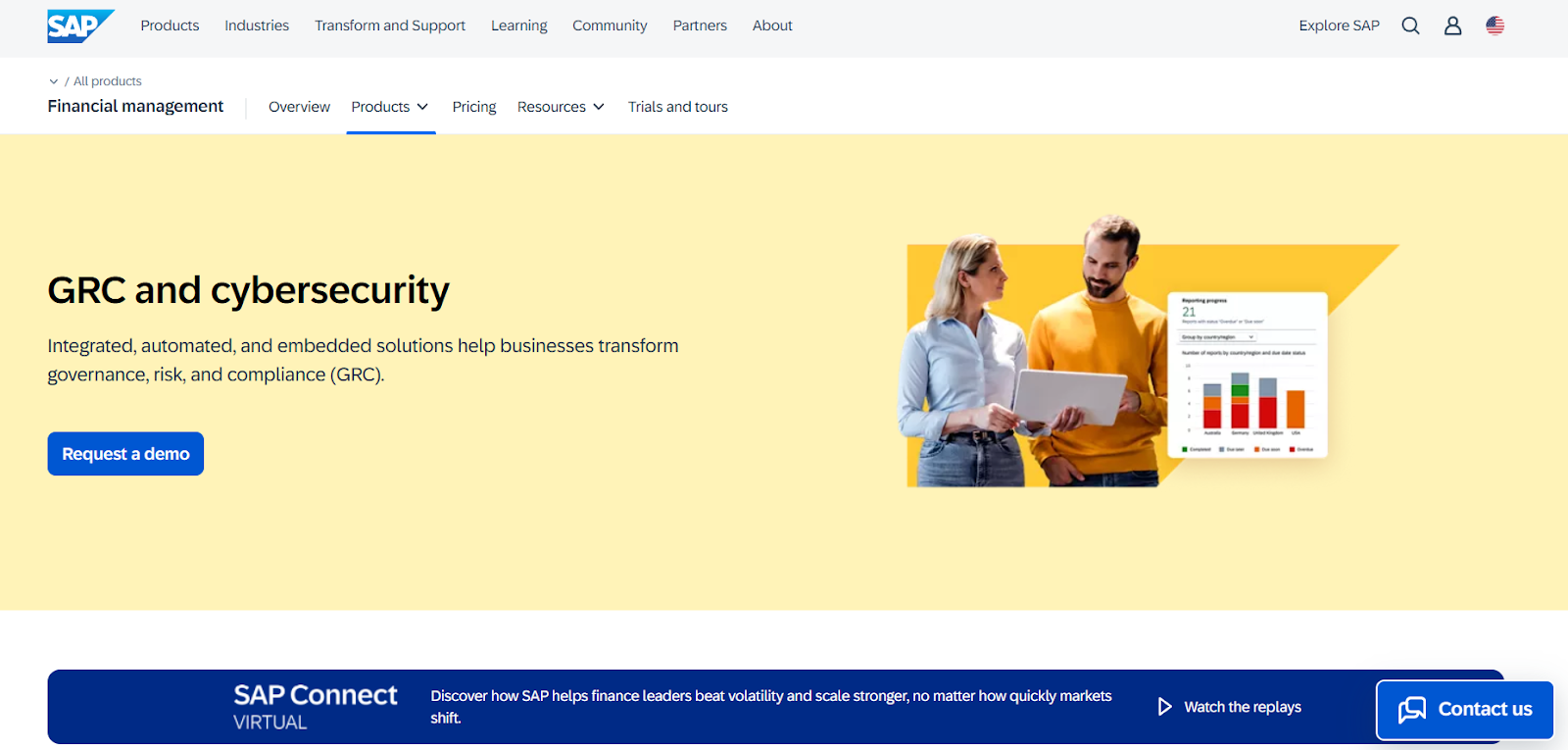
SAP GRC is a mature, enterprise-grade governance, risk and compliance suite built to embed risk and compliance directly into core business processes.
Its strength comes from full SAP ERP integration, rich control frameworks and large-scale deployment capabilities, but it tends to favour complex setups and organizations with heavy SAP usage.
Standout features
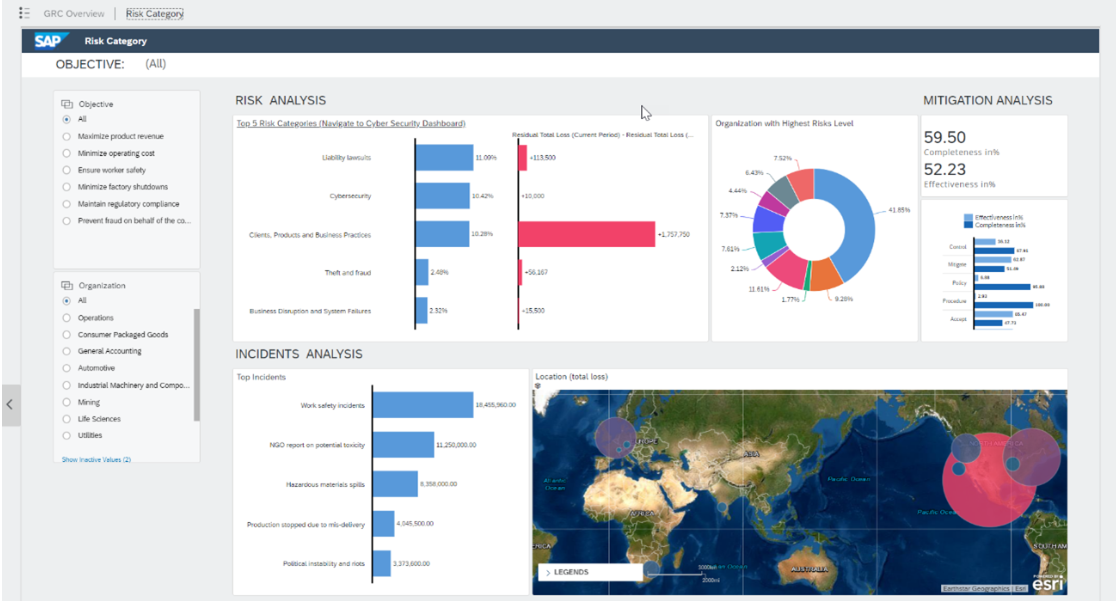
- Tight SAP ecosystem integration: Pulls data directly from SAP modules (e.g., finance, supply chain) and aligns GRC workflows with underlying business operations for real-time context and deeper control.
- Access control & compliance automation: Includes powerful modules like Access Risk Analysis, Role Management, Emergency Access Management and User Access Review to mitigate segregation of duty (SoD) and role-based risks across systems.
- Audit, risk and control monitoring: Enables continuous monitoring and assessment of controls, audit workflows, and risk registers, giving large enterprises a centralised view of compliance and control status.
Pricing
SAP GRC doesn’t publish standalone pricing for its GRC suite, since it’s offered as part of the broader SAP S/4HANA Finance ecosystem.
However, SAP provides two primary Finance packages that serve as the foundation for its GRC and financial-control capabilities, both deployed in the public cloud via S/4HANA:
- SAP Finance Base: $291/user/month, includes financial, revenue, and cost accounting, AX, trade, and reporting compliance, cash, liquidity, and working-capital management, etc.
- SAP Finance Premium: $408/user/month, includes everything in Base, plus advanced subscription and revenue management, customer experience and enterprise-service management, corporate expense and procurement orchestration, and project and resource management features.

Both plans have a minimum requirement of 25 users, with contract duration available upon request.
For organizations needing more advanced functionality, SAP also offers several add-on modules, whose pricing is available only via a custom quote.
If you want to learn more about SAP GRC pricing plans and value for money, don’t miss our in-depth pricing review.
Pros & Cons
✅ Works seamlessly with other SAP modules, creating a unified governance and reporting environment.
✅ Highly customizable risk scoring and analytics allow you to set up tailored risk metrics and dashboards that fit your workflows.
❌ Limited integration flexibility - while powerful within the SAP ecosystem, connecting with external systems often requires additional expertise or middleware.
3. Workiva
Best for: Organizations that want to combine financial reporting, audit, ESG, and risk management into one platform.
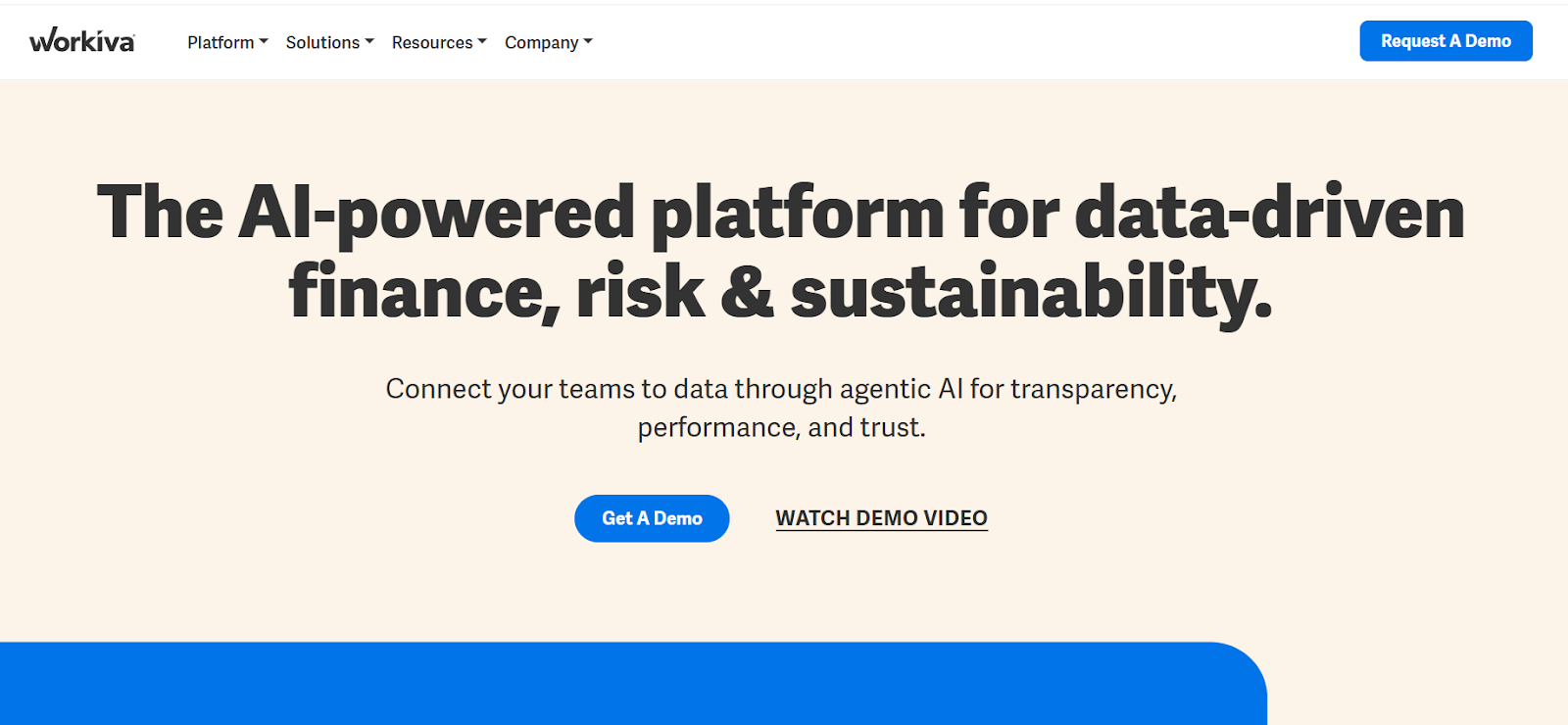
Workiva offers a cloud-native platform that unifies governance, risk, compliance and reporting workflows so teams no longer juggle disconnected tools.
It’s designed to give you one shared workspace for control testing, audit-ready documentation, and real-time transparency.
Standout features

- Intelligent Search: Empowers users to effortlessly explore their entire Workiva workspace by locating key data points within files, cells, and slides to accelerate reporting and decision-making.
- Workiva AI: Transforms GRC operations with built-in intelligence that automates risk analysis, enhances compliance assurance, and delivers audit-ready insights instantly.
- Strong reporting & transparency: It delivers role-based dashboards and audit trails across all workflows, providing you with a centralized risk view.
Pricing
Workiva doesn’t publish standardized pricing, as costs probably depend on scope, modules, user counts, and deployment needs.
You’ll need to request a quote to see how licensing and costs scale for your use case, or take a look at our in-depth pricing guide that breaks down all the details.
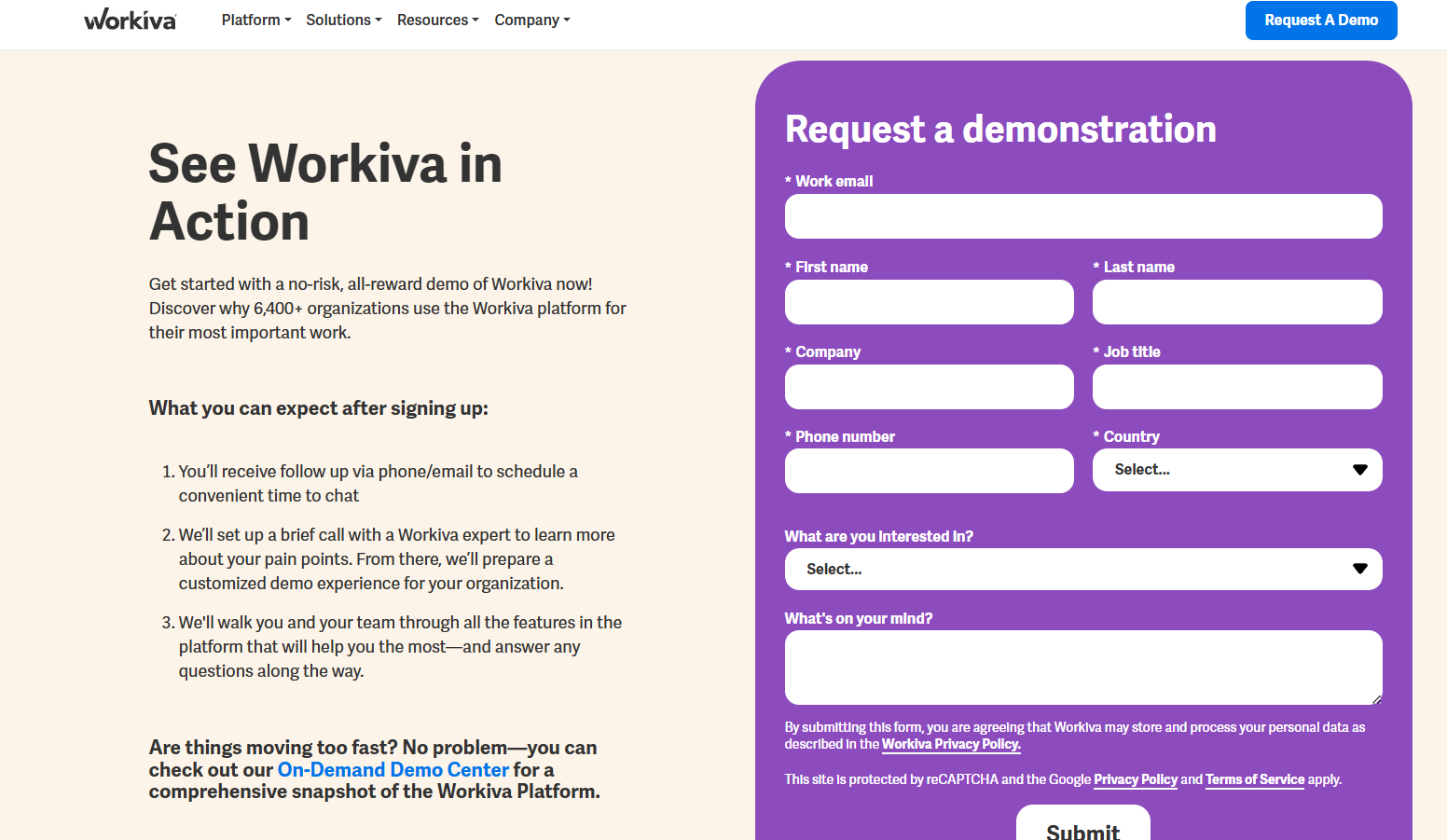
Pros & Cons
✅ Intuitive and user-friendly interface.
✅ Seamless collaboration with real-time co-editing, version control, and built-in audit trails that eliminate email chains and manual reconciliation.
❌ Feature gating, with some essential functions (e.g., advanced search or bulk editing) requiring premium tiers.
4. MetricStream
Best for: Large enterprises operating across multiple geographies and regulations.
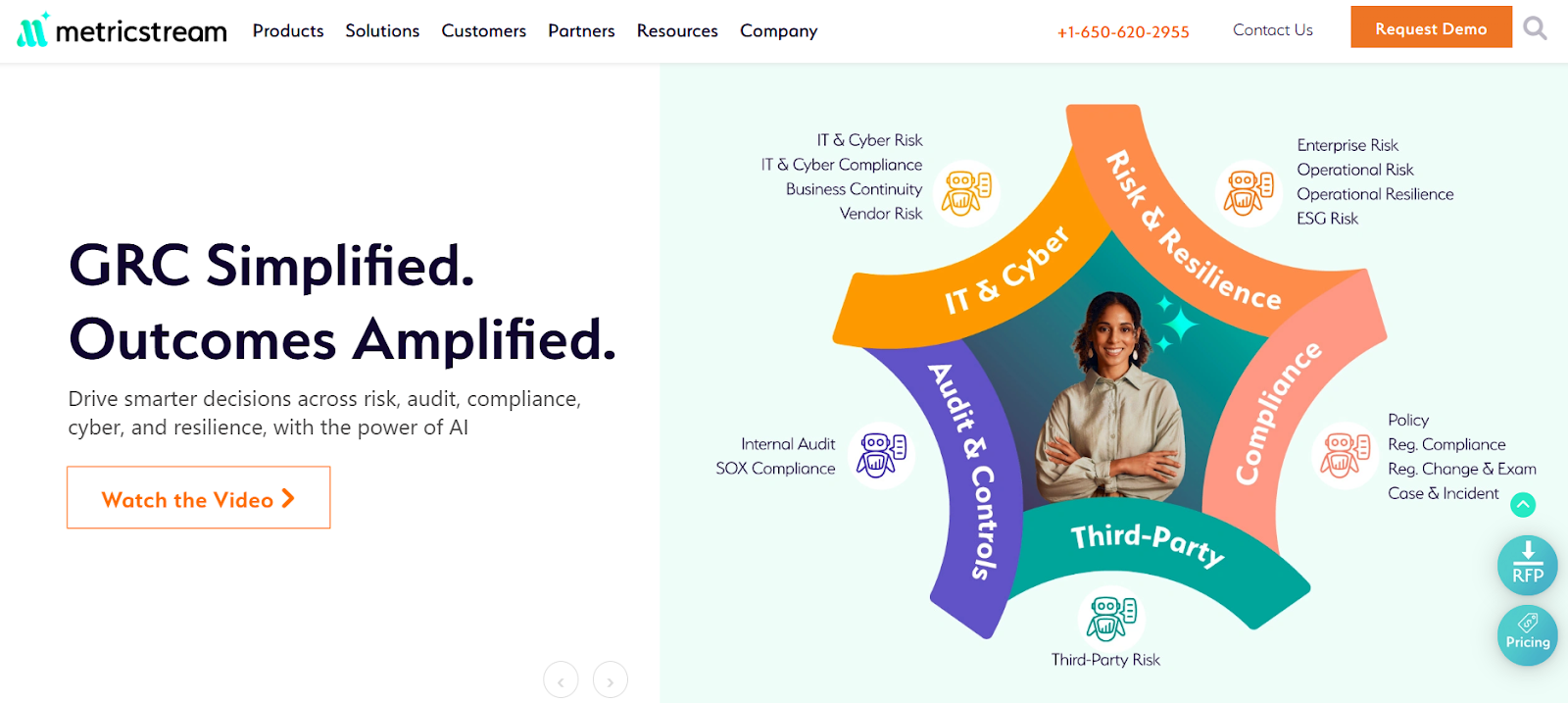
MetricStream is an AI-first, connected GRC platform built for scale, designed to deliver real-time risk insights, continuous control monitoring, and integrated compliance workflows.
With its comprehensive modules and strong enterprise credentials, it offers breadth and depth, but it comes with complexity and cost.
Standout features
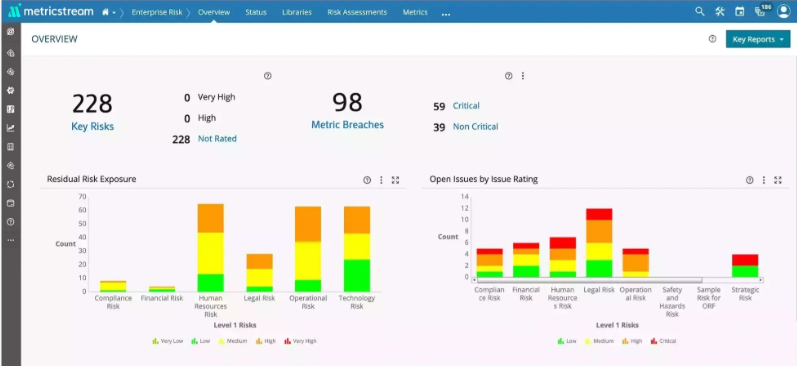
- AI-powered analytics and control insights: The platform uses embedded analytics and AI to prioritise controls, detect gaps, and surface actionable risk patterns.
- Regulatory change automation & continuous monitoring: The solution automates regulatory tracking, policy-to-control mapping and real-time monitoring of compliance obligations.
- Third-party & resilience management: Built-in modules allow organizations to onboard, assess and monitor vendor risk, plus simulate business-continuity scenarios for resilience planning.
Pricing
MetricStream doesn’t disclose its prices.
You can request a demo to learn more.
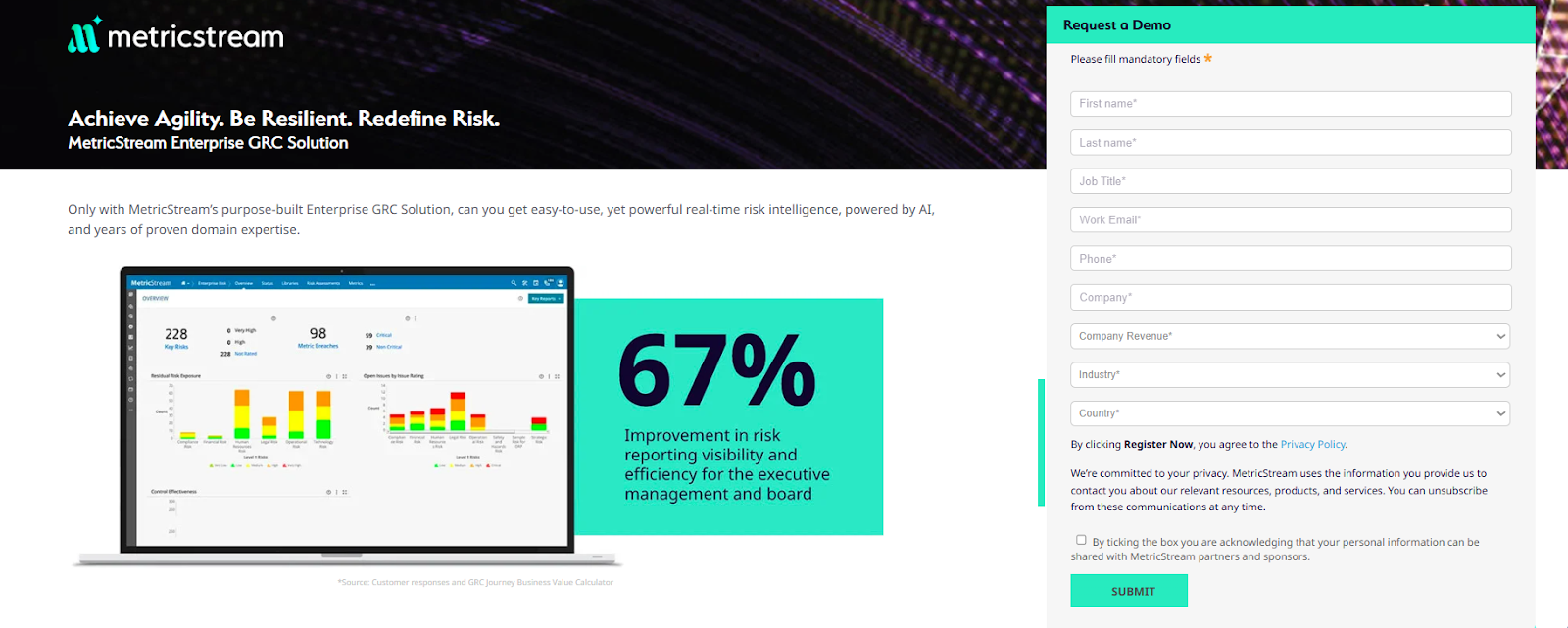
To get a clearer sense of MetricStream’s pricing structure before requesting a quote, head over to our full pricing review.
Pros & Cons
✅ Fully integrated risk management framework gives you end-to-end control over risk workflows.
✅ Highly customizable and configurable.
❌ Steep learning curve and outdated interface.
5. LogicManager
Best for: Mid-to-large organizations seeking a configurable risk and compliance platform that supports a wide variety of GRC workflows without enterprise-style complexity.

LogicManager is a cloud-based GRC/ERM platform that emphasises usability and guided setup, offering pre-built risk models, dashboards, assessments, and advisory support to help teams centralise risk, compliance, and audit workflows.
Its strength lies in flexibility and service-oriented support, but it may require time to unlock full customisation and reporting power.
Standout features

- AI-powered Risk Ripple Analytics: Detects hidden risk interdependencies across departments with AI-driven insights, helping to take preventive action before issues escalate.
- Regulatory & policy compliance program: Transforms static obligations into actionable controls, mapping policies directly to risks, controls and incidents within dashboards.
- Enterprise-grade dashboards: Customizable views, heat-maps and board-ready reports turn data into actionable intelligence from front-line staff to executives.
Pricing
LogicManager doesn’t publish pricing information.
However, its modular structure implies that you will probably be charged separately for each module you need.
If you want more details about LogicManager’s cost, you can request a custom quote on its website, or check our detailed pricing review and skip the hassle.

Pros & Cons
✅ Flexible configuration options let teams tailor assessments, workflows, and forms to specific organizational needs without relying on coding.
✅ Robust automation capabilities help streamline ongoing compliance and audit cycles without friction.
❌ Its reporting features are unintuitive and have limited flexibility.
6. Riskonnect
Best for: Enterprises that want a single, connected view of operational, insurable, and strategic risk across the business.
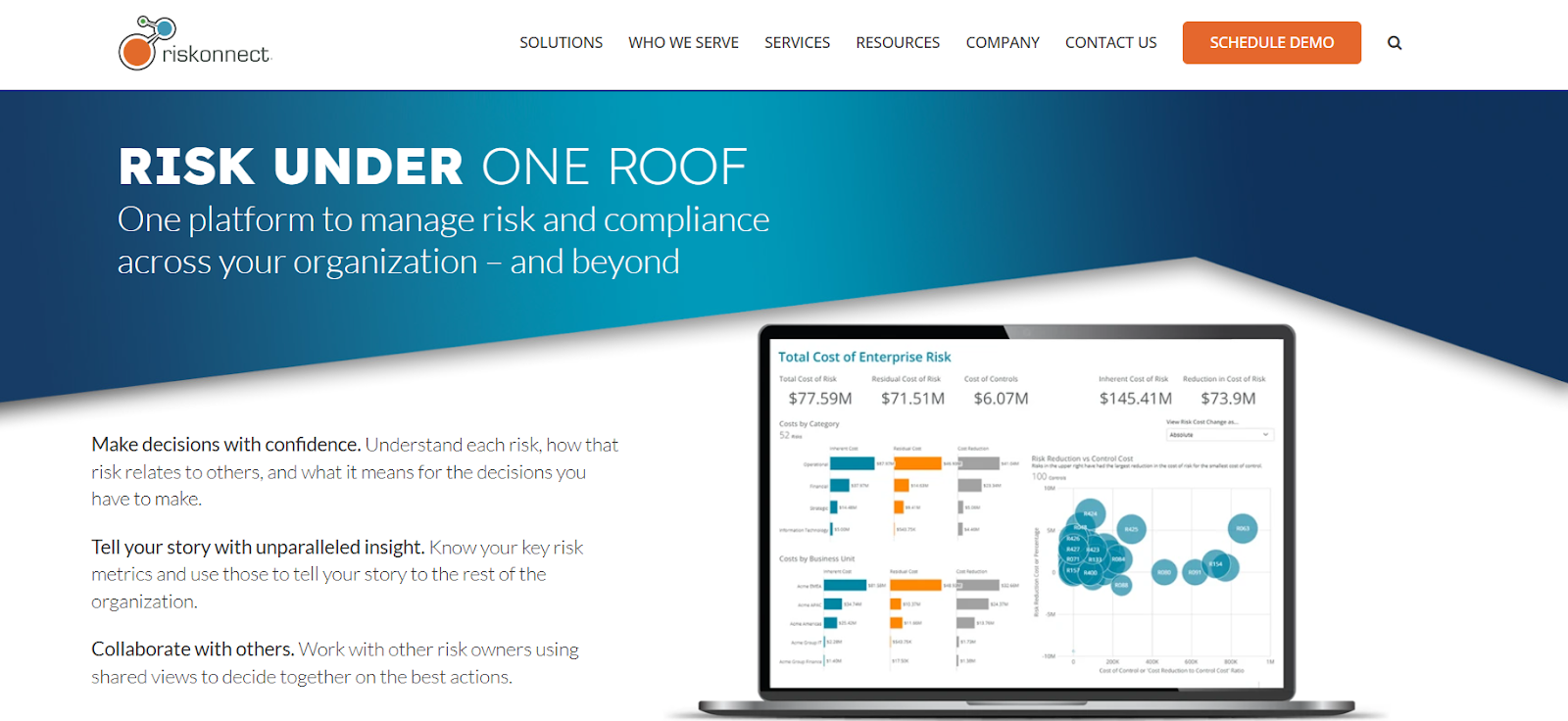
Riskonnect is an integrated risk management platform that unifies enterprise risk, safety, insurance/claims, vendor risk, business continuity, and compliance in one system so leadership can see how risks connect and where exposure is rising.
It’s built for organizations that need a real-time, audit-ready source of truth rather than scattered spreadsheets and siloed workflows.
Standout features
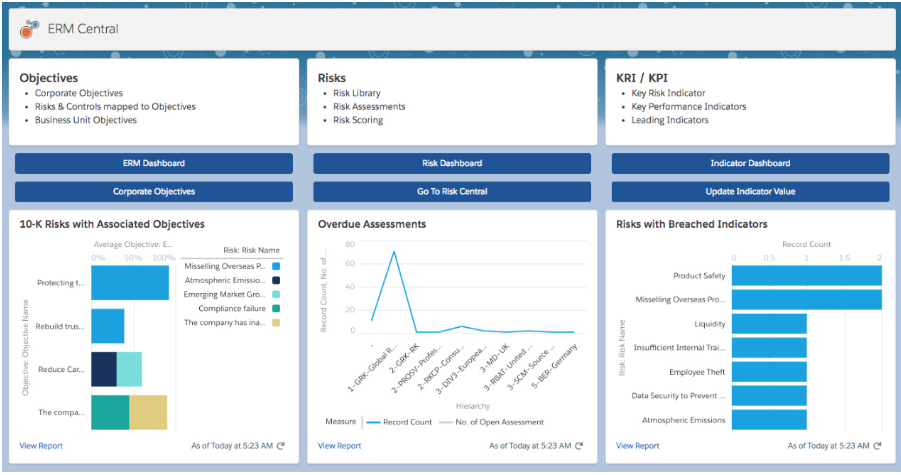
- Connected enterprise risk view: Maps strategic, operational, regulatory, cyber, and third-party risks in one place, so teams can see how a single issue (e.g. an incident or control failure) cascades across departments.
- Incident, claims, and safety management: The platform captures events in the field, ties them to insurance claims and remediation tasks, and stores everything in an auditable record so nothing slips through.
- Business continuity & resilience: Teams can plan, test, and track continuity strategies inside the same platform they use for risk and incident data, making resilience part of daily operations.
Pricing
Riskonnect doesn’t list standard pricing publicly.
Instead, pricing is modular and user-based, depending on which modules you adopt (e.g. ERM, RMIS, audit, TPRM) plus service and implementation fees.
You can learn more about Riskonnect’s capabilities and pricing through a tailored demo, or dive into our comprehensive pricing guide for all the details.
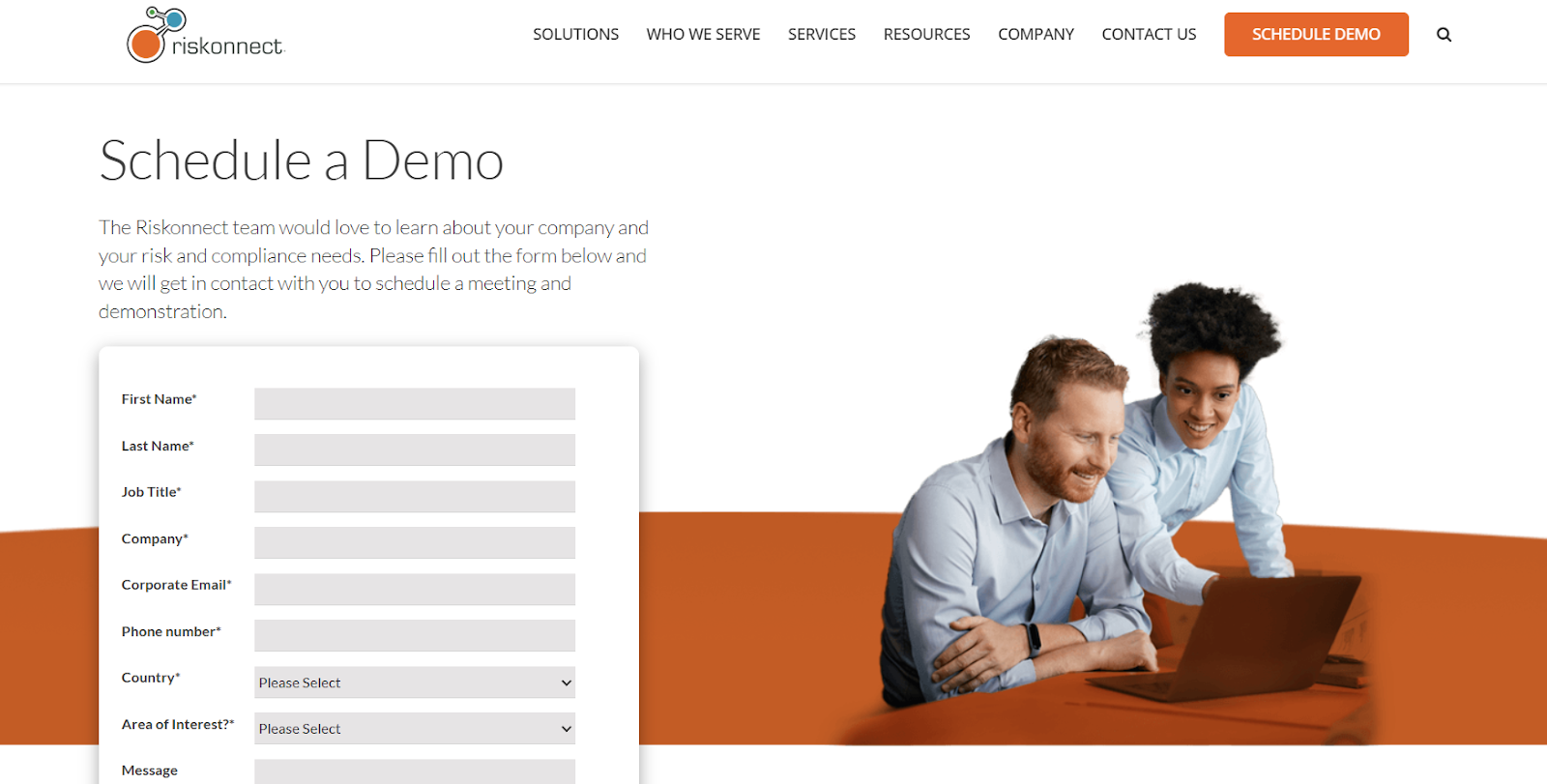
Pros & Cons
✅ Highly configurable and adaptable.
✅ Modern analytics give leadership real-time visibility into trends and emerging issues.
❌ Pricing falls in the enterprise-budget range.
7. Diligent
Best for: Enterprises seeking a unified platform for board governance, risk, audit, and compliance with a strong focus on executive visibility, ESG reporting, and real-time assurance.
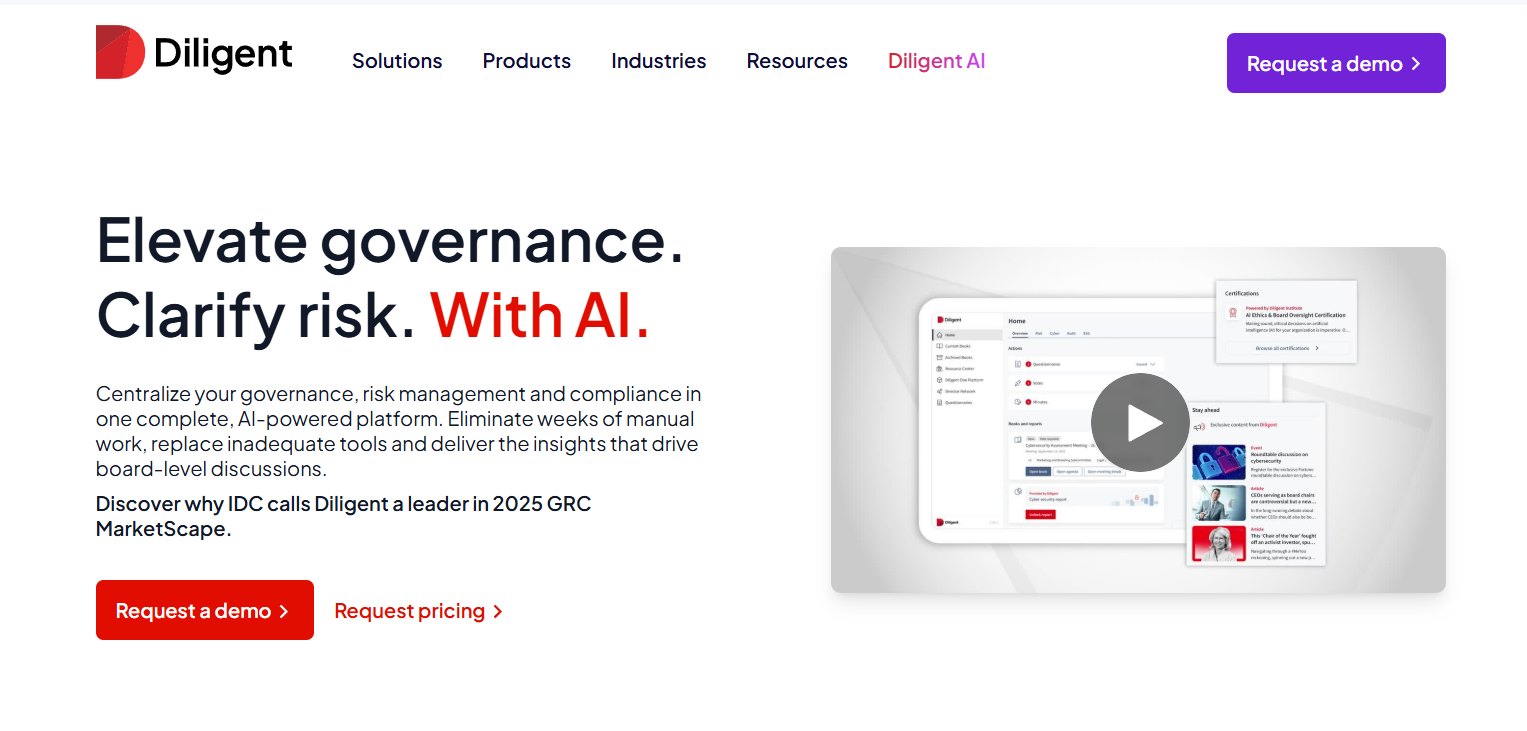
Diligent is a leading enterprise GRC platform designed to help organizations connect risk, compliance, audit, and board governance in a single, secure ecosystem.
Its focus on leadership-level visibility and board-ready insights makes it a preferred choice for global enterprises aiming to modernize governance and decision-making.
Standout features
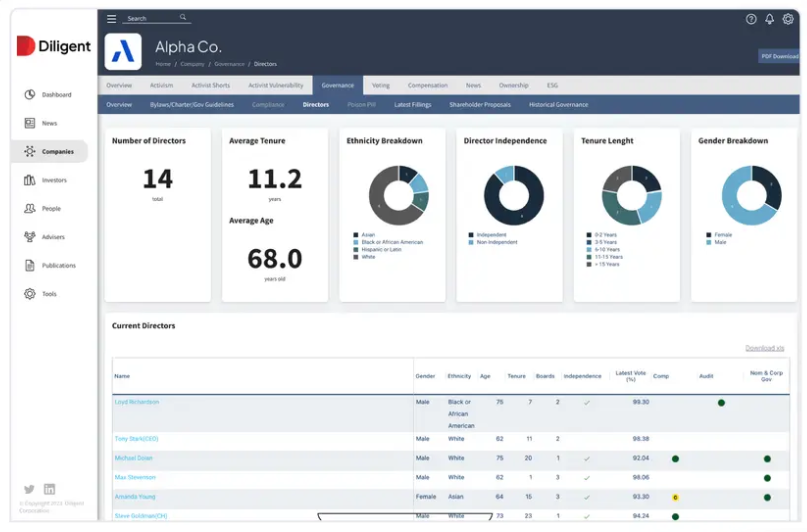
- Real-time risk and audit analytics: Diligent’s data-rich dashboards connect audit findings, control gaps, and risk indicators, giving leadership an always-updated view of organizational exposure.
- AI-powered insights and automation: Diligent leverages AI for risk detection, automated control monitoring, and document summarization.
- ESG and sustainability management: Built-in ESG and climate disclosure tools help organizations track performance, manage frameworks like CSRD, and prepare investor-grade sustainability reports.
Pricing
There’s no public pricing information for Diligent.
You can connect with their team for a quote, or read our pricing analysis to understand typical costs.
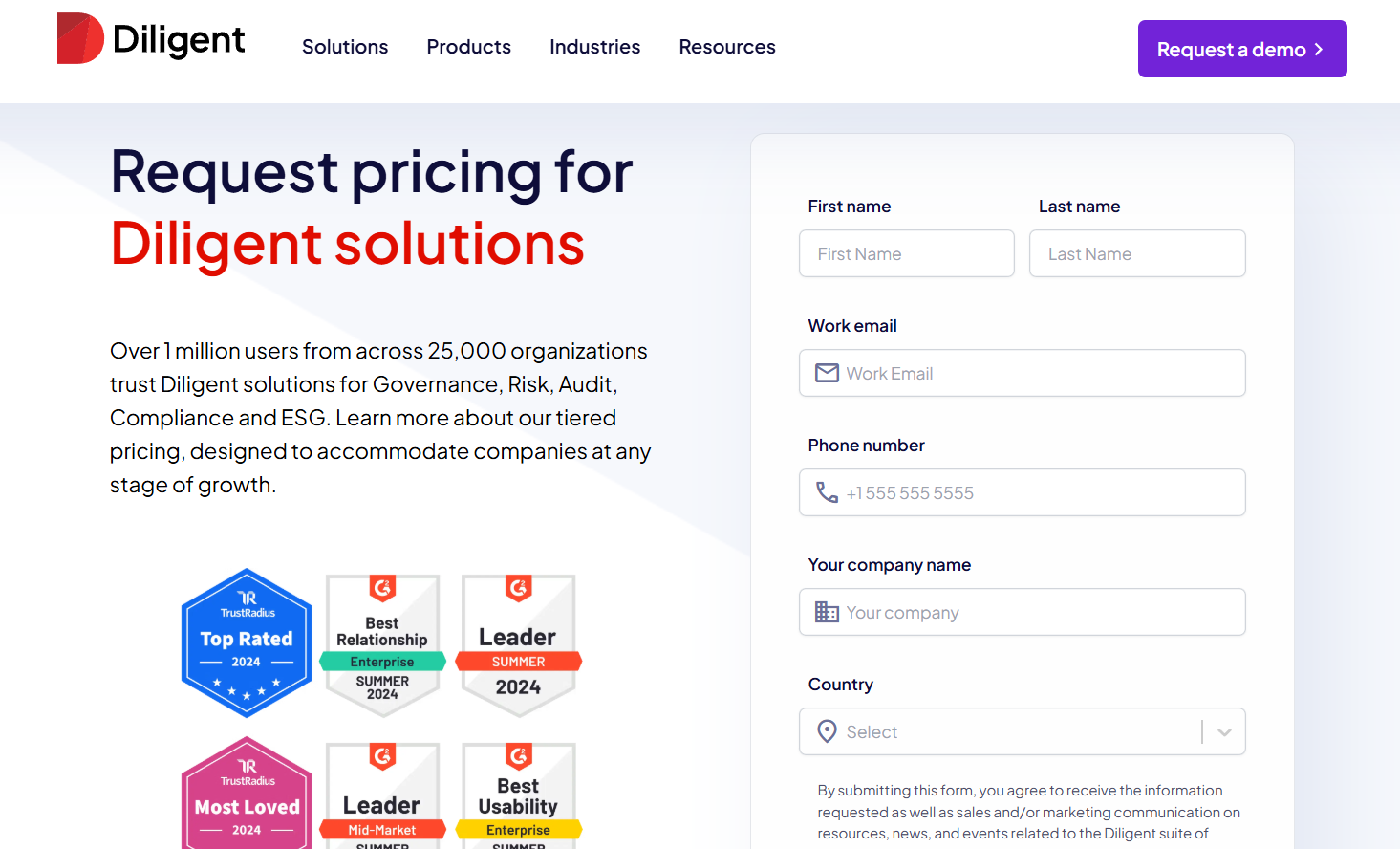
Pros & Cons
✅ Powerful board management and reporting features with excellent data security and document control.
✅ Unites enterprise risk, compliance, audit, internal controls, and ethics programs under one platform, helping you manage assurance holistically rather than in silos.
❌ Has a steep learning curve.
8. Resolver
Best for: Organizations that need a connected platform to manage enterprise risk, audit, security, compliance, and brand reputation from a single, resilience-driven system.
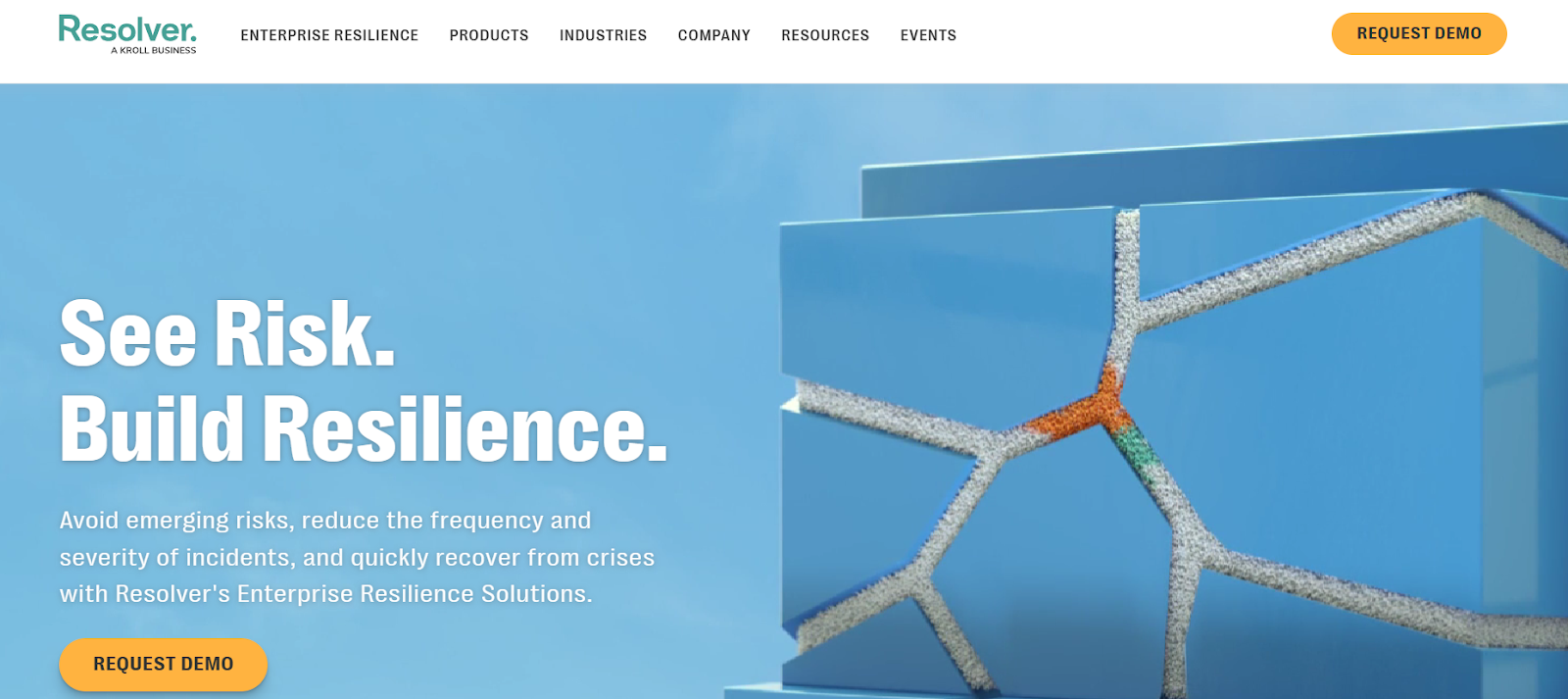
Resolver is an enterprise-grade risk intelligence platform built to help organizations anticipate, mitigate, and recover from threats before they escalate.
Unlike traditional GRC tools, Resolver combines risk, audit, incident, and brand reputation management into one integrated ecosystem that turns risk awareness into measurable resilience.
Standout features
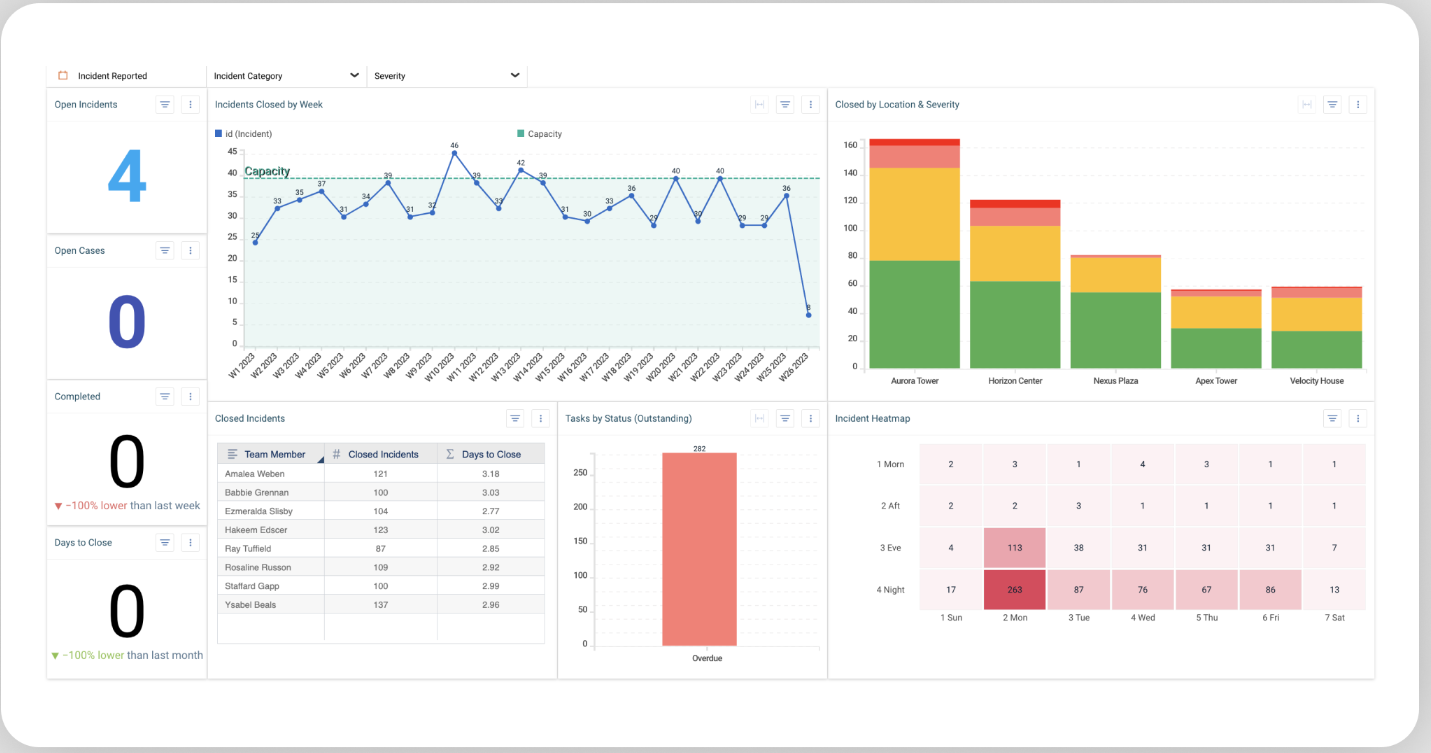
- Compliance management: Translates complex, multi-jurisdictional requirements into clear, trackable obligations with automated accountability workflows and evidence tracking.
- Enterprise security & investigations: Provides built-in root-cause analysis, threat intelligence, and rapid response capabilities to reduce losses and downtime.
- Brand Equity Protection: Uses AI-powered social listening, content moderation, and reputation monitoring to detect and mitigate digital risks, helping brands prevent harmful chatter, safeguard online communities, and protect executives, products, and partners from reputational threats.
Pricing
Resolver uses a flexible, custom-quote pricing model rather than fixed subscription tiers.
Costs depend on the specific modules you choose, the level of customization required, and the number of users involved in managing your risk programs.
To get an accurate estimate tailored to your organization’s needs, you’ll need to contact Resolver’s sales team directly.
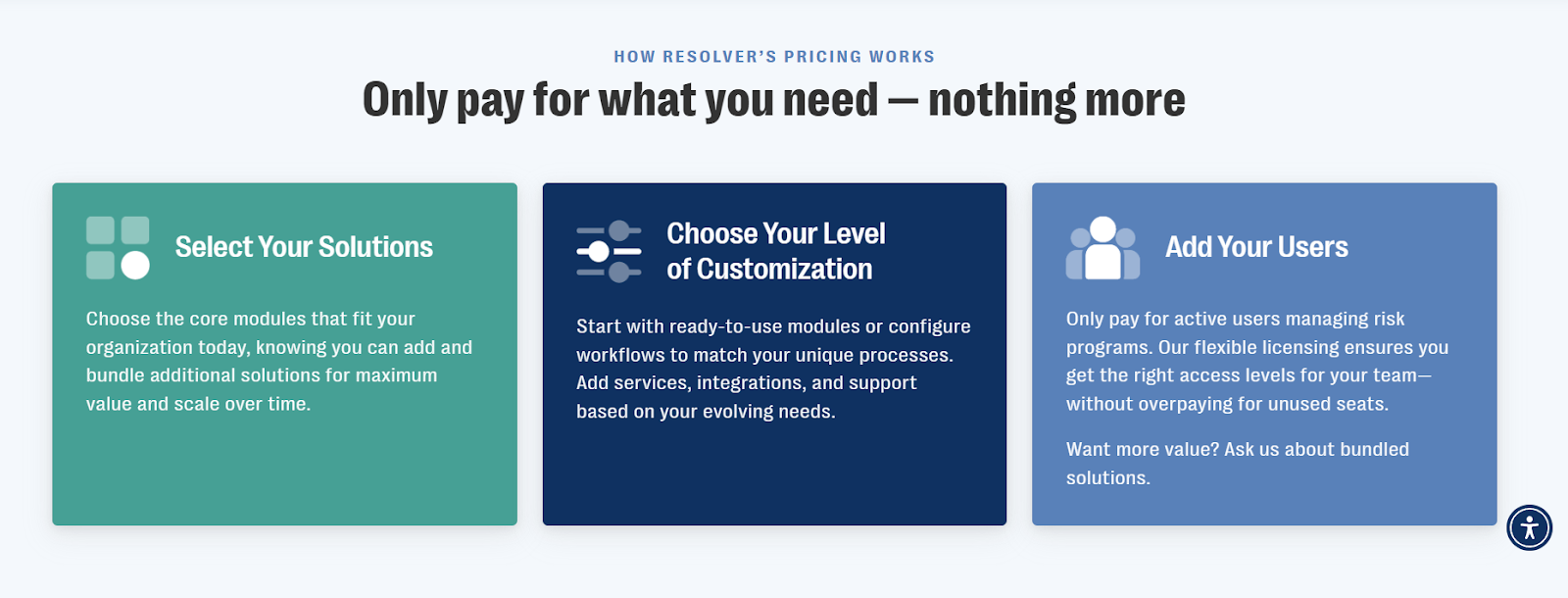
Pros & Cons
✅ Highly customizable and adaptable to various needs and organizational structures.
✅ Strong reporting and visualization tools.
❌ Deep configuration or orchestration changes often need help from Resolver’s implementation team.
9. Protecht
Best for: Organizations that seek a highly configurable, AI-powered enterprise-grade GRC platform where risk, controls, compliance, audit and incident workflows are unified with strong analytics and no-code adaptability.
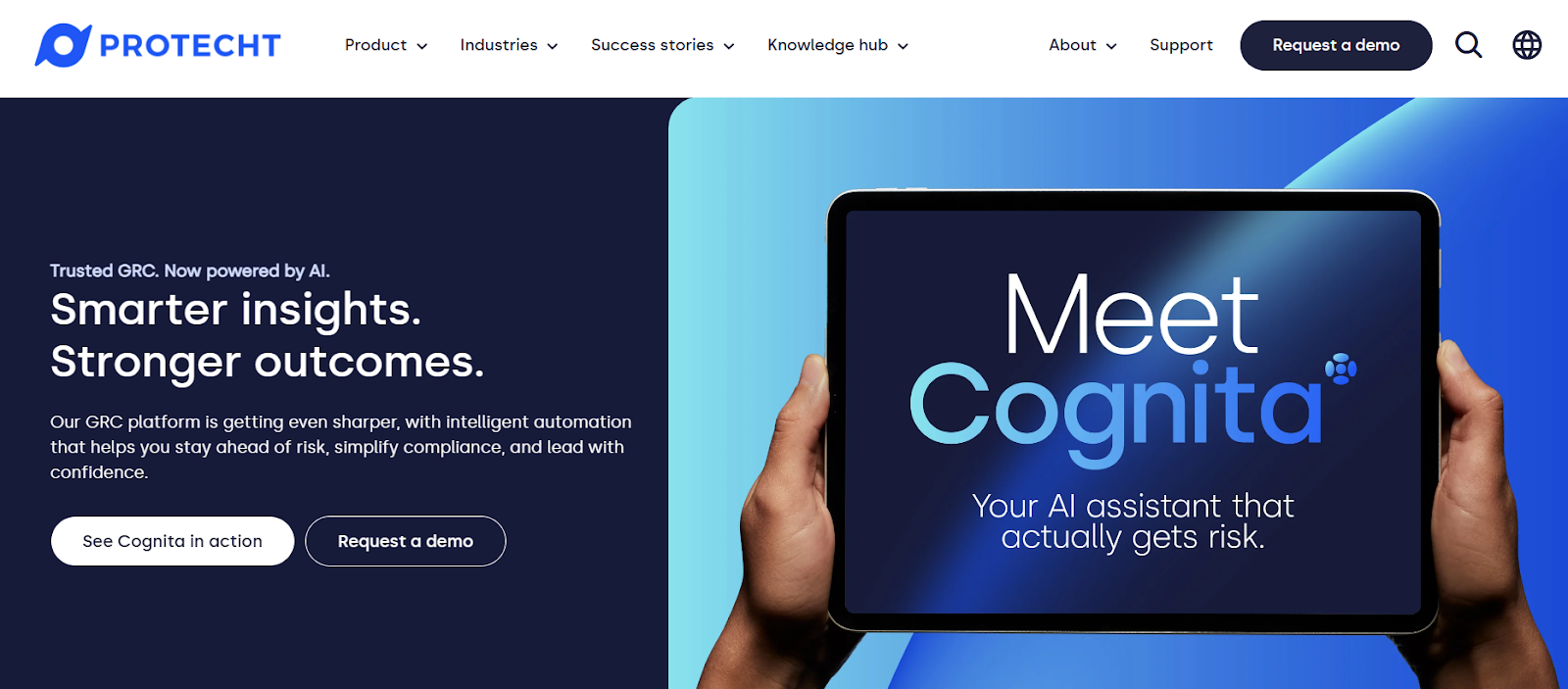
Protecht offers a single, scalable platform to capture, assess and respond to risk across the entire organization, helping link risks to controls, incidents, KRIs and business objectives.
It’s designed for teams that want deep flexibility without being locked into rigid workflows or coding-heavy customisations.
Standout features

- Cognita: Protecht’s AI-powered risk assistant that blends deep risk expertise with trusted automation, helping teams capture incidents accurately, analyze root causes, and make smarter, compliant decisions in real time.
- Connected risk lifecycle view: Protecht ties together risk appetite, risk registers, incidents, controls, KRIs and issues into one structured system so you can trace root causes and exposure across domains.
- Dynamic, no-code configuration: Users can build their own data capture forms, workflows, taxonomies, dashboards and reports without needing developer support.
Pricing
Protecht doesn’t list public pricing tiers or predefined packages.
Instead, it uses a custom-quote model, with annual licensing fees determined by the number and type of users in your organization.
Extra charges apply for advanced modules - like Operational Resilience or pre-built templates from the Protecht Marketplace - depending on your configuration needs.
To get more information, you can request a demo from its team or take a look at our in-depth Protecht pricing review.
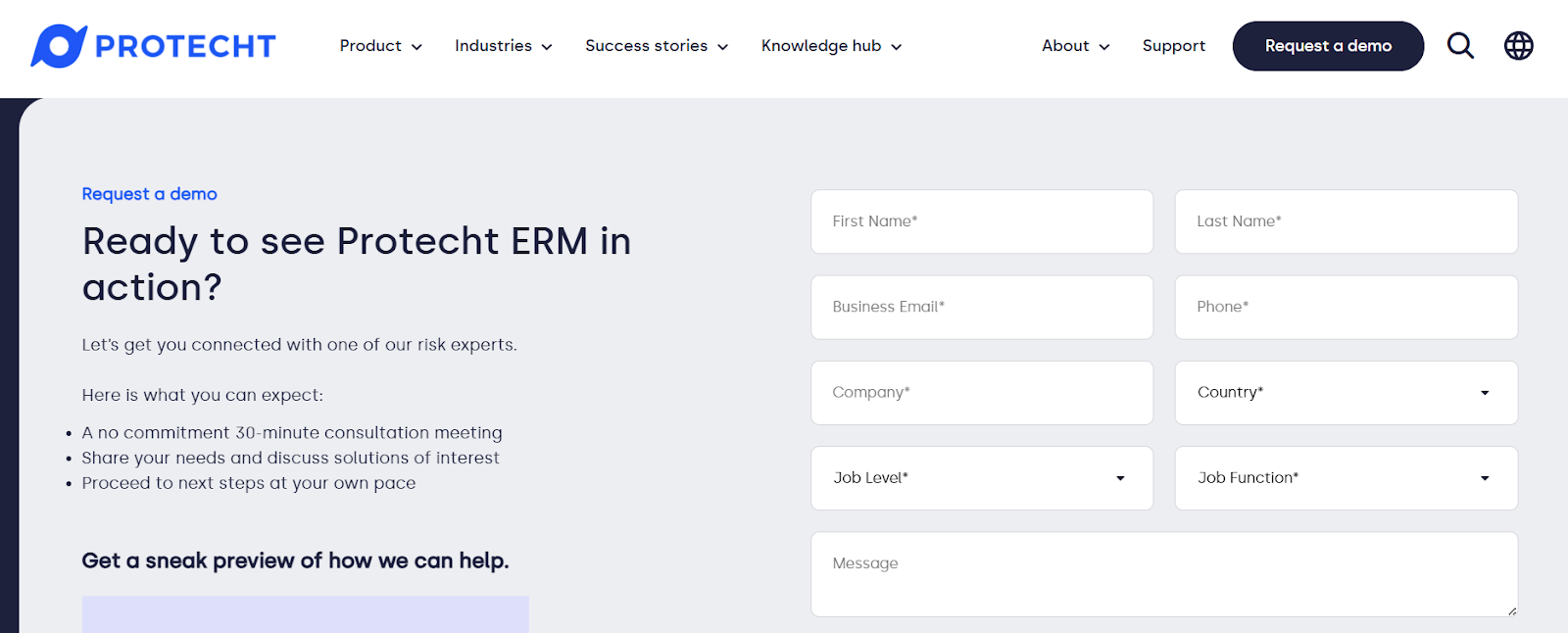
Pros & Cons
✅ Highly customizable and flexible without coding.
✅ Offers a variety of customizable dashboards that give stakeholders clear visibility into risk exposure and performance.
❌ Steep learning curve and dated UI.
10. SureCloud
Best for: Organizations seeking an intelligent, event-based GRC platform that unifies compliance, risk, audit, and privacy management while scaling seamlessly from small teams to large enterprises.
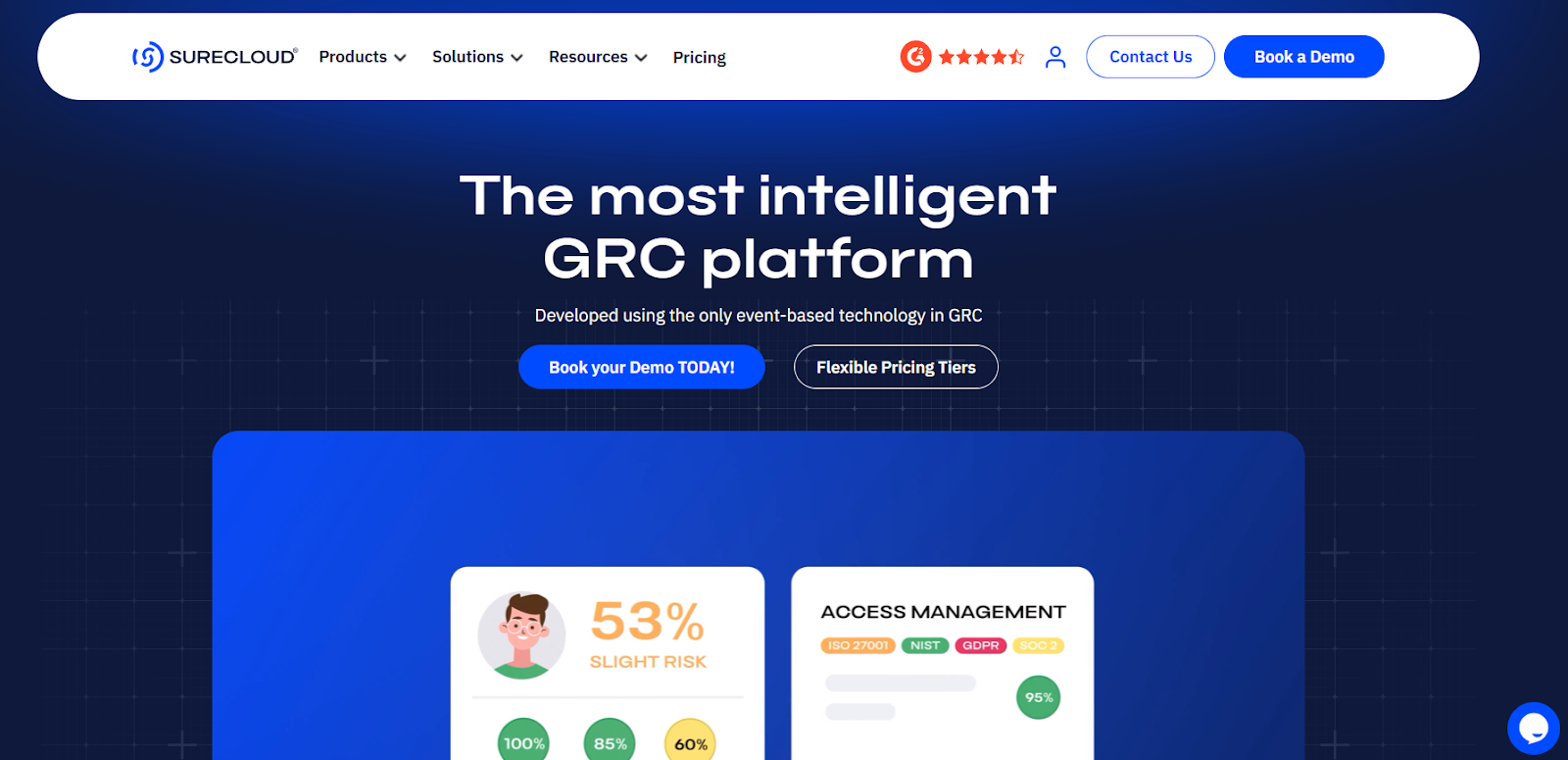
SureCloud is a cloud-based GRC platform built on event-based technology.
As such, it automatically updates workflows, assessments, and controls as new information or incidents occur, replacing fragmented spreadsheets and static reports with a dynamic system that connects all GRC processes.
Standout features

- Regulatory compliance management: Map controls intelligently across multiple frameworks (ISO 27001, SOC 2, GDPR, DORA, NIST, and more), eliminating duplication and reducing assessment fatigue.
- Cyber risk and third-party management: Identify, assess, and track IT, cyber, and vendor risks in one place with automated scoring, self-service questionnaires, and evidence collection.
- AI-enhanced intelligence: Leverage generative AI to reduce manual reviews, surface insights from documents, and assess the quality of policies and controls.
Pricing
SureCloud offers two pricing tiers designed to fit different GRC maturity levels and organizational needs:
- Foundations: Starting from £15,000/year, aimed at helping growing teams get compliant and stay compliant faster.
- Enterprise: Custom pricing, built for established organizations managing complex GRC environments.

However, to learn more about the features each plan includes and the actual cost for your organization, you’ll have to contact its team.
Pros & Cons
✅ Ready-to-use modules and templates, which can be configured for different frameworks and deployed within weeks.
✅ Highly customizable and adaptable.
❌ Limited reporting and clunky dashboards.
Next steps: Finding the right Origami Risk alternative for your GRC goals
While Origami Risk remains a powerful and respected player in enterprise risk and insurance management, the landscape in 2026 has evolved.
Platforms like SmartSuite lead this new generation by offering unified, no-code GRC environments where risk, compliance, audit, and vendor oversight all live in one connected workspace.
Others, like SAP GRC, Workiva, and MetricStream, continue to serve enterprises needing deep integration and analytics, while other solutions, such as Protecht, Resolver, and SureCloud deliver agility, AI-driven insights, and speed that older systems can’t easily match.
The right choice ultimately depends on your size, risk maturity, and desired balance between configurability and simplicity.
If you’re ready to move past complexity and bring your entire governance program into one modern, transparent platform - SmartSuite is the clear next step.
One workspace. Every GRC workflow. No legacy friction.
Start your free trial or book a demo today to see how it compares firsthand.
Read more
- 10 Best Vendor Management Software & Tools In 2026 - Discover the top vendor management platforms helping teams automate onboarding, monitor risk, and strengthen supplier relationships in 2026.
- Corporater Pricing: Is It Worth It For GRC In 2026? - Uncover what drives Corporater’s pricing, how it compares to leading GRC suites, and whether its enterprise-grade control is worth the investment.
- 10 Best Vanta Alternatives & Competitors In 2026 - See which GRC and compliance tools outperform Vanta this year for automation, scalability, and audit-readiness.
- SAI360 Pricing: Is It Worth It In 2026? - A complete breakdown of SAI360’s pricing structure, including what you actually pay for, and whether it delivers real GRC value in 2026.
- 10 Best OneTrust Alternatives For GRC In 2026 [Reviewed] - Explore the best OneTrust alternatives for privacy, risk, and compliance, tailored for teams that want agility without losing enterprise power.
- LogicGate Pricing: Is It Worth It In 2026? - Find out how LogicGate’s modular pricing really works, what features drive costs, and how it stacks up against newer GRC contenders.

Run your entire business on a single platform and stop paying for dozens of apps
- Manage Your Workflows on a Single Platform
- Empower Team Collaboration
- Trusted by 5,000+ Businesses Worldwide















